







It’s boom times again for Alberta, with recent forecasts noting that job creation is running at a brisk 5.6 per cent and predicting the provincial economy will continue growing well above the national rate.
But accompanying the rebound are familiar recruitment challenges, and this year’s winners of the Alberta’s Top Employers competition provide insight into how these challenges are being met. The Alberta competition is organized by the editors of the national Canada’s Top 100 Employers project, who annually single out the employers in Alberta that lead the way when it comes to recruitment and retention.
Like the national competition, the editors of Alberta’s Top Employers annually release their picks for the best employers. The winners are chosen based on the
same criteria as the national competition, including compensation and benefits, work and social atmosphere, the quality of the physical workplace, training and upward mobility.
Richard Yerema, executive editor at Canada’s Top 100 Employers, points out that the post-pandemic jobs market is characterized by “revolutionary speeds of change” and that unprecedented demand, the ongoing labour shortages, and other factors “mean that much more skill is required in managing the workforce.”
Overall, a targeted approach to recruitment, focusing on inclusion and ensuring that mental health needs are met are some of the ways companies are attracting new blood. This challenge is
made more acute in northern communities across Canada.
Case in point: the Regional Municipality of Wood Buffalo in Fort McMurray. “We have a 1,450-member full-time workforce and are seeking new recruits for a multitude of business areas, from water treatment to finances,” says Kari Donnelly, director of human resources. “Attracting newcomers has always been a challenge in our neck of the woods.”
Wood Buffalo is overcoming that challenge by establishing five coordinators who cover five different areas of the municipality’s operations. “They are specialists with a keen understanding of what we require, and their expertise enables them to find the appropriate recruit,” Donnelly explains.
Capping this is a strategy that many companies in remote communities across Canada are undertaking: marketing job opportunities as part of a unique rural lifestyle where outdoor activities abound.
As for retention, Wood Buffalo has undertaken an aggressive course of growing talent from within. “Our model is in the office instead of remote working, so it’s critical we give our employees the ability of internal movement,” Donnelly says. A well-oiled machine prioritizes employees’ well-being
Increasingly, new recruits expect benefits that support their mental health and family. “Demand for these two elements has become huge,” Donnelly says. “We provide a lot of training focused on mental health and augment it with access to the
Calm app and psychological first aid.”
Inclusivity is equally important to recruitment strategies: a wide range of companies believe that their receptivity to different people, cultures and beliefs not only sets them apart from the competition but also makes for an energetic and productive workplace, and fosters trust.

This is most evident at WCB Alberta. The administrator of the Workers’ Compensation Act has invested in improving employee well-being, providing health and wellness spending accounts (up to $3,000) and increasing paramedical coverage in the past year to enhance reimbursement for psychologist, physical therapy, massage therapy, chiropractor and acupuncture services.
At ATCO (a provider of integrated energy, housing, transportation and infrastructure solutions), flexibility is emphasized in nurturing its workforce. The company’s Flex benefits program allows staff to choose from a variety of health and dental combinations while also accessing a health and lifestyle spending account to cover extra expenses. Flex Days provides them with a simple way to supplement vacation days when needed.
Trends to watch in 2023
Moving into the spring, the winners of the competition have identified several notable trends: a shift in demand for new skills in areas like tech and analytics; recruiting the right people and then giving them every opportunity to advance; and providing further flexibility so employees can fit their career to what is important in their lives.
Yerema says that while flexibility is a must for any type of employer, it should be part of a greater package of benefits: “Alberta has been doing better than a lot of other provinces in the last few years and companies realize that a wide variety of strategies are necessary to attract and retain the best talent.”

As the work world continues to move further away from the dark days of the pandemic, the ingredients that have always enabled employers to stand out from the crowd are more important than ever. Good wages are one thing, but initiatives that make jobs meaningful and workplaces desirable are what really drives recruitment – and inspires loyalty.
– Robin BrunetThe following organizations have been chosen as Alberta’s Top Employers for 2023 (employee counts refers to full-time staff):

ABSORB SOFTWARE INC., Calgary. Learning management systems; 283 employees.
Introduced a flex allowance to cover costs associated with remote work such as home office equipment, transit costs and gym memberships.
AGRICULTURE FINANCIAL SERVICES CORPORATION / AFSC, Lacombe. Insurance and lending for agriculture producers; 491 employees. Offers retirement planning courses tailored to employees over and under 45 years of age.
ALBERTA BLUE CROSS, Edmonton. Health and medical insurance; 1,172 employees. Provides up to 12 paid personal days off each year to help employees balance personal and professional commitments.
ALBERTA CENTRAL, Calgary. Credit union financial support services; 104 employees. Manages a vacation purchase program, allowing full- and part-time employees to purchase up to five days of additional vacation per year.
ALBERTA GAMING, LIQUOR & CANNABIS / AGLC, St. Albert. Provincial crown corporation, gambling, liquor and cannabis regulation; 1,015 employees. Manages the “Active@AGLC” program featuring a variety of wellness initiatives including fitness challenges, yoga sessions and stress reduction events.
ALBERTA HEALTH SERVICES / AHS, Edmonton. Healthcare services; 49,928 employees. Maintains a comprehensive health and wellness action plan to foster a healthy and resilient workforce.
ALBERTA INNOVATES, Edmonton. Economic development programs; 402 employees. Offers coverage for mental
health practitioners as part of its benefits plan, to $1,500 per year.
ALBERTA INVESTMENT MANAGEMENT CORPORATION / AIMCO, Edmonton. Provincial crown corporation, investment management services; 518 employees. Manages an internal rewards program to encourage positive recognition, providing award recipients with redeemable “AIMCoins”.
ALBERTA PENSIONS SERVICES CORPORATION / APS, Edmonton. Pension funds; 311 employees. Encourages employees to save for the future with contributions to a defined benefit pension plan.
ALBERTA SCHOOL EMPLOYEE BENEFIT PLAN / ASEBP, Edmonton. Employment benefits plan administrators; 181 employees. Encourages lifelong learning with generous tuition subsidies for courses taken at external institutions,
up to $5,000 annually.
ALBERTA SECURITIES COMMISSION / ASC, Calgary. Provincial government, financial regulation services; 212 employees. Offered a one-time work from home allowance of $1,000 and provides interestfree loans for employees interested in enhancing their home offices, up to $3,500.
ALBERTA TEACHERS’ ASSOCIATION, THE, Edmonton. Professional organizations; 146 employees. Supports employees who are new mothers with maternity leave top-up, to 100 per cent of salary for up to 17 weeks.
APPEALS COMMISSION FOR ALBERTA WORKERS’ COMPENSATION, Edmonton. Administration of human resource programs; 90 employees. Helps employees nearing retirement transition with phased-in work options, allowing them to gradually reduce their hours.
AQUATERA UTILITIES INC., Grande Prairie. Waste management services; 164 employees. Encourages employees to give back to the community with paid time off to volunteer.
ATCO GROUP, Calgary. Energy, transportation and infrastructure development; 5,336 employees. Encourages employees to adopt an ownership mentality through a share purchase plan, available to all permanent employees.
BENNETT JONES LLP, Calgary. Law firms; 1,059 employees. Along with existing alternative work options, employees may be able to take advantage of a formal hybrid work program that lets them work from one to three days offsite each week.
BIRCHCLIFF ENERGY LTD., Calgary. Natural gas production; 208 employees. New employees start with three weeks of paid vacation and experienced candidates’ previous work experience is considered when setting individual vacation entitlements.
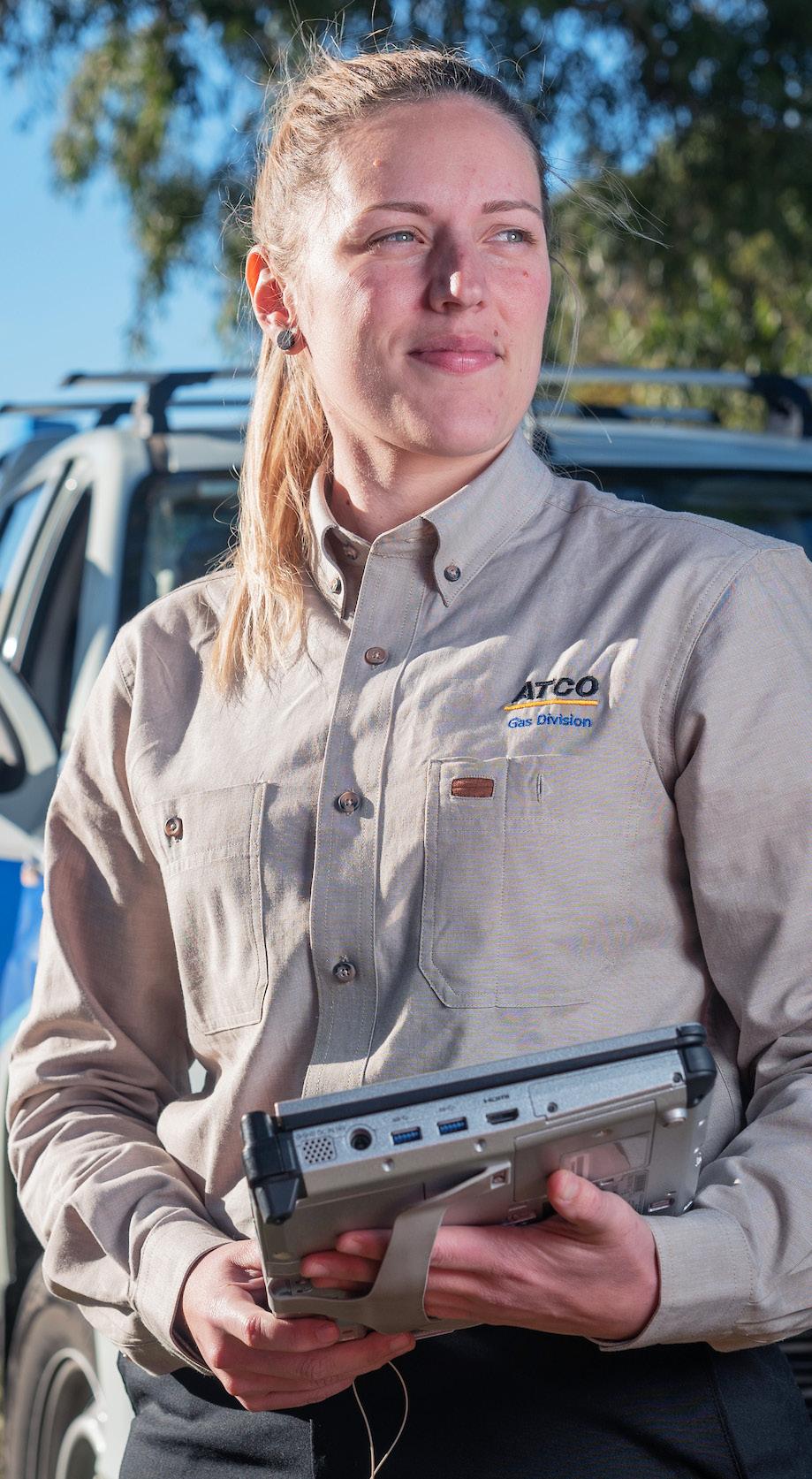
BLUEARTH RENEWABLES INC., Calgary. Renewable power generation; 114 employees. Encourages employees to become recruiters for the firm with generous new employee referral bonuses, to $2,500 depending on the position.
BOARDWALK REIT, Calgary. Real estate investment trust; 1,577 employees. Offers compassionate leave top-up for those called upon to care for a loved one in need, to 100 per cent of salary for up to six weeks.
BOW VALLEY COLLEGE, Calgary. Post-secondary education; 592 employees. Helps employees plan for the future with a defined benefit pension plan along with phased-in work options when nearing retirement.
CALGARY AIRPORT AUTHORITY, THE, Calgary. Airport operations; 256 employees. Provides maternity leave top-up payments for its new moms, to 93 per cent of salary for up to 15 weeks.
CALGARY CO-OPERATIVE ASSOCIATION LIMITED, Calgary. Supermarkets and grocery stores; 1,132 employees. Encourages ongoing professional development throughout an employee’s career, including paid internships, apprenticeships, formal mentoring and tuition subsidies.
CALGARY POLICE SERVICE, Calgary.
Police services; 2,953 employees. Encourages healthy lifestyles through an onsite wellness facility that features a full-size gymnasium, instructor-led training and variety of onsite health services.
CALGARY ROMAN CATHOLIC SEPARATE SCHOOL DISTRICT, Calgary. Elementary and secondary schools; 5,636 employees. Health plan features a generous mental health practitioner benefit, up to $1,750 annually.
CALGARY WEST CENTRAL PRIMARY CARE NETWORK / CWC PCN, Calgary. Health care; 127 employees. Has encouraged employees to keep connected through a number of virtual employee social clubs, from a cooking and recipe roundup club to a podcast (listening) club.
CANADA ENERGY REGULATOR, Calgary. Federal government, regulation of the oil, gas, and electric utility industries; 539 employees. Actively encourages mental health awareness through a formal mental health committee and offers generous coverage for mental health practitioner services, to $2,000 annually.
CANADIAN PACIFIC RAILWAY
LIMITED, Calgary. Railroad transportation; 9,138 employees. Supports ongoing employee development through apprenticeships, mentoring, paid internships, in-house training, leadership development and generous tuition subsidies.
CAPITALCARE GROUP INC., Edmonton. Residential care facilities; 581 employees. Head office employees are encouraged to keep fit with subsidized memberships to a fully equipped onsite fitness facility.
CHAMPION PETFOODS LP, Edmonton. Dog and cat food manufacturing; 488 employees. Employees receive six paid discretionary days that can be used for appointments, personal time or sick days, with unused amounts transferred to a health spending account.
CHARTERED PROFESSIONAL ACCOUNTANTS OF ALBERTA, Edmonton. Professional organizations ; 113 employees. Introduced a hybrid work program the lets employees design work arrangements to “meet their personal and business needs”.
CONVERGINT TECHNOLOGIES LTD., Calgary. Computer systems design services; 722 employees. Funded by donations from employees and the company, the Ken LaChance Colleague Emergency Fund provides up to $5,000 to employees who experience unforeseen economic hardship.
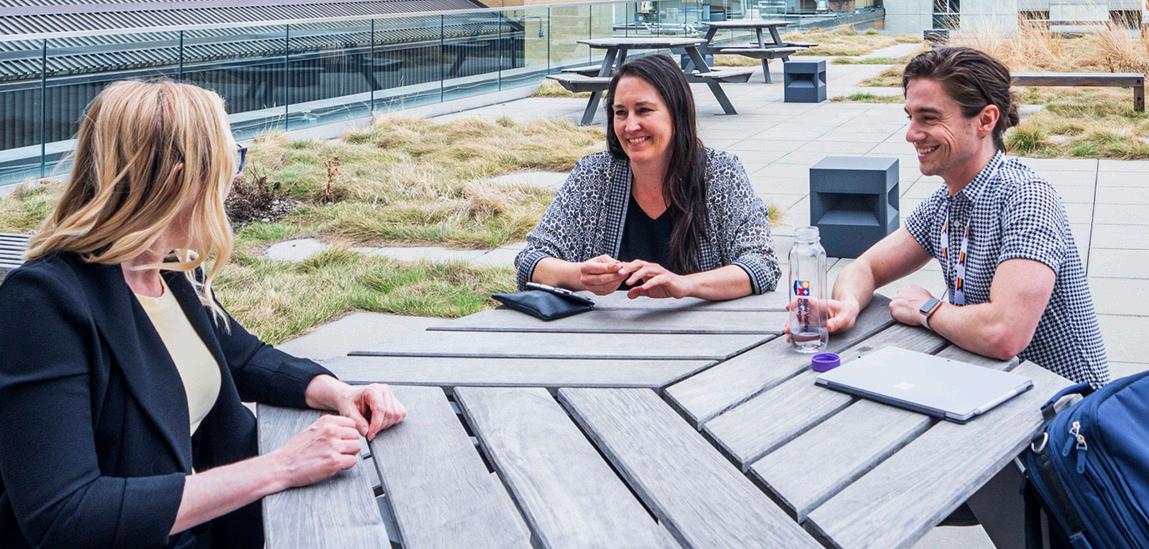


CORTEVA AGRISCIENCE CANADA, Calgary. Agriscience research and development; 707 employees. Starts new employees with four weeks of paid vacation as well as offering additional paid time off during the Christmas holidays.
COVENANT HEALTH, Edmonton. Healthcare and continuing care services; 2,905 employees. Helps employees prepare for life after work through retirement planning workshops along with defined benefit pension and matching RSP plans, varying by employee group.
DENTONS CANADA LLP, Edmonton. Law firms; 1,357 employees. Supports new parents-to-be with generous fertility treatment support, adoption assistance as well as extending maternity and parental leave top-up to all new parents.
DUNCAN CRAIG LLP, Edmonton. Law firms; 96 employees. Along with a variety of existing alternative work options the firm has introduced a formal hybrid work option that features up to two offsite days each week.
DYNALIFE DX, Edmonton. Medical laboratories; 913 employees. Supports ongoing employee development through tuition subsidies for post-secondary courses, with no annual max.

EDMONTON CATHOLIC SEPARATE SCHOOL DIVISION, Edmonton. Elementary and secondary schools; 3,824 employees. Helps employees plan for a secure future with contributions to a defined benefit pension plan and health benefits coverage to 65 years of age.
ENBRIDGE INC., Calgary. Energy infrastructure; 7,384 employees. Encourages healthy lifestyle choices through a formal wellness program that includes financial incentives for participating in wellness activities, up to $350 per year.
ENMAX CORPORATION, Calgary. Electric power distribution; 1,549 employees. Helps employees save for the longer term through defined benefit and defined contribution pension plans, varying by employee group.
ENVERUS, Calgary. Software developers; 283 employees. Employees are encouraged to recruit their friends with generous new employee referral bonuses, to $1,500 depending on the position.
EPCOR UTILITIES INC., Edmonton. Electric power distribution and water

Continued treatment services; 2,988 employees. Helps employees prepare for life after work with generous contributions to a defined benefit pension plan and a health benefits plan that extends to 65 years of age.
FLUOR CANADA LTD., Calgary. Engineering services; 1,277 employees. As part of their flexible health benefits plan, employees have access to generous mental health health coverage that ranges up to $5,000 annually.
FORTISALBERTA INC., Calgary. Electric power distribution; 1,108 employees. Supports ongoing professional development throughout an employee’s career, from apprenticeships and paid internships to generous tuition subsidies courses at outside institutions.
GIBSON ENERGY INC., Calgary. Oil and gas distribution; 434 employees. Helps out familiesto-be with generous fertility treatment support and adoption subsidies, to a lifetime maximum of $30,000.
GILEAD ALBERTA ULC, Edmonton. Pharmaceutical manufacturing; 501 employees. Offers generous new employee referral bonuses when employees help to successfully recruit new candidates, up to $2,500 depending on the position.

GRAHAM GROUP, Calgary. Industrial, commercial and institutional building construction; 1,942 employees. Offers a generous mental health practitioner benefit as part of the health plan along with an accessible wellness hub on its intranet that features a range of helpful resources.
IMPERIAL OIL LIMITED, Calgary. Oil and gas production and distribution; 5,429 employees. Helps employees plan securely for the future with a defined benefit pension plan and health benefits that extend to retirees with no age limit and shared premiums.
INTER PIPELINE LTD., Calgary. Petroleum transportation, storage and natural gas liquids processing; 1,159 employees. In addition to three weeks of starting vacation, employees have access to 12 paid flex days to help balance personal and family commitments.
KEYERA CORP., Calgary. Crude petroleum and natural gas extraction; 1,000 employees. Health benefits plan features a health spending account that lets employees top up existing levels of coverage, move to savings or share purchase options, or just take as pay.
LAC LA BICHE COUNTY, Lac La Biche. Municipal governments; 195 employees. Encourages employees to keep fit with subsidized memberships to an onsite fitness facility along with numerous activities organized by a formal wellness committee.
LAFARGE CANADA INC., Calgary. Concrete manufacturing; 6,286 employees. Helps employees save for the future through defined contribution and benefit plans as well as offering retiring employees the option to gradually reduce their work hours.
LAKELAND COLLEGE, Vermilion. Post-secondary education; 313 employees. Helps employees prepare for the future with retirement planning assistance services and contributions to a defined benefit pension plan.

MAWER INVESTMENT MANAGEMENT LTD., Calgary. Financial planning and investment management; 213 employees. Provides generous maternity and parental leave top-up payments for new mothers and fathers, to 100 per cent of salary for up to 25 weeks.
MERCER PEACE RIVER PULP LTD., Peace River. Pulp and paper manufacturing; 304 employees. Encourages employees to support initiatives in the community by matching volunteer hours with financial donations of $500 for every 40 hours.
NAIT / NORTHERN ALBERTA INSTITUTE OF TECHNOLOGY, Edmonton. Post-secondary education; 1,744 employees. Supports families with maternity leave top-up for new mothers along with a variety of flexible work arrangements, including hybrid work options.
NOVATEL INC., PART OF HEXAGON , Calgary. Satellite communications systems; 398 employees. Along with helping employee save with matching RSP contributions, employees can ease into life after work with phased-in retirement work options.
OLYMPIA FINANCIAL GROUP INC., Calgary. Trust, fiduciary and custody activities and related IT services companies; 241 employees. Employees can tailor their health benefits through a generous health spending account that ranges up to $7,500 annually.
PASON SYSTEMS CORP., Calgary. Energy services and technology systems; 299 employees. Introduced a one-time salary increase last July to help employees absorb the
rising costs of goods and services during this time.
PCL CONSTRUCTION, Edmonton. Industrial, commercial and institutional building construction; 2,697 employees. Helps employees prepare for life after work with retirement planning assistance services along with a defined contribution pension plan.
PEMBINA PIPELINE CORPORATION, Calgary. Natural gas distribution; 2,160 employees. Helps employees save with a defined contribution pension plan and lets them share in the company’s successes through share purchase and year-end bonus programs.
PRIMED MEDICAL PRODUCTS, INC., Edmonton. Disposable medical products; Medical product manufacturing; 170 employees. Supports its new moms with maternity leave top-up payments and offers the option for employees to extend their leave into an unpaid leave of absence.
RIVA INTERNATIONAL, INC. , Edmonton. Software publishers; 93 employees. Provides new employee referral bonuses when employees help to successfully recruit a candidate, up to $1,000 for each successful hire.
ROGERS INSURANCE LTD., Calgary. Insurance agencies and brokerages; 443 employees. Manages the inspirational Dreams Program that awards four employees annually with $10,000 to help them fulfill their lifelong dreams.
ROYAL ALEXANDRA HOSPITAL FOUNDATION, The, Edmonton. Hospital Charitable organizations; 28 employees. Supports its new mothers with maternity leave top-up payments up to 95 per cent of salary for up to 17 weeks.
RÜMI, Calgary. Property maintenance services; 154 employees. Introduced an evolving hybrid work model for eligible roles that features no set number of days working in-office, along with ergonomic support for home office set-ups.
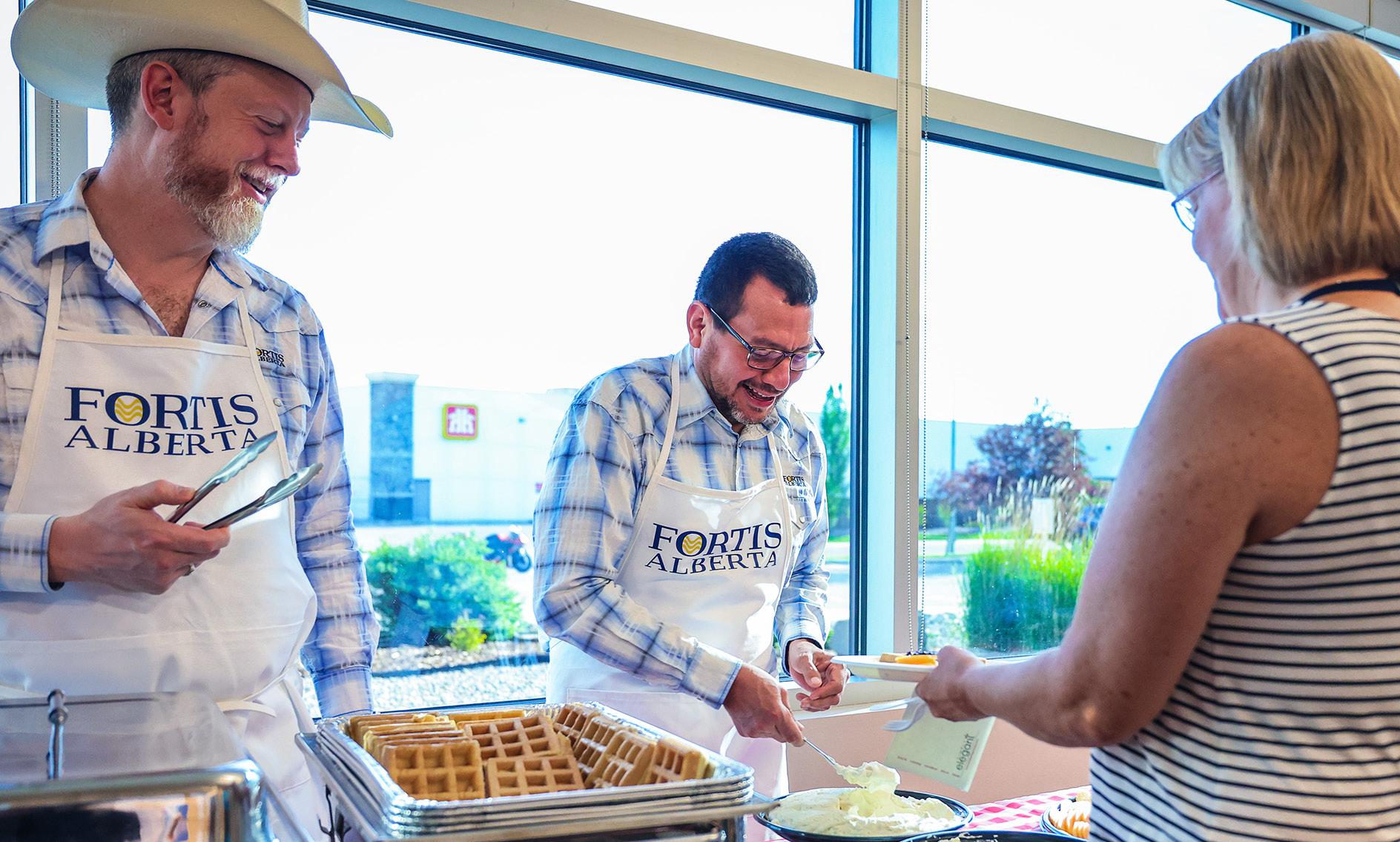
SAIT, Calgary. Post-secondary education; 2,484 employees. Launched a new online well-being hub that includes weekly Wellbeing Labs on a variety of health topics and features the unique online Headversity resilience app.
SHELL CANADA LIMITED, Calgary. Oil and gas production and distribution; 3,522

Continued employees. Encourages employees to support community initiatives with three paid volunteer days along with matching charitable donations for volunteer work, to $1,500 for every 60 volunteer hours.
SILVACOM LTD., Edmonton. Custom computer software and consulting; 100 employees. As part of their health plan, employees receive $1,200 flex dollars that can be allocated towards additional coverages, purchase of extra vacation or transferred to savings.
TRANSLATIONAL RESEARCH IN ONCOLOGY, Edmonton. Clinical research activities; 138 employees. Offers hybrid and remote work options for office-based employees that includes a one-time
payment of $500 for home office set-ups and a $70 monthly internet subsidy.
UFA
CO-OPERATIVE LIMITED, Calgary. Farm supplies merchant wholesalers; 1,034 employees. Maintains a flex days policy that features up to 17 flex days per year, including one day per month and five additional days during the Christmas holiday season.
UNIVERSITY OF CALGARY, Calgary. Post-secondary education; 5,872 employees. Manages a comprehensive mental health strategy that includes workshops, training and resources as well as the dedicated UFlourish Week mental health awareness campaign.
WESTERN FINANCIAL GROUP INC., High River. Insurance and financial services; 1,931 employees. Manages a unique Supporting Our Staff (SOS) fund to help out employees in
need of emergency financial relief due to a personal or family crisis.
WOOD BUFFALO, REGIONAL MUNICIPALITY OF, Fort McMurray. Municipal governmenst; 1,420 employees. Helps employees raising a family along the way, from maternity leave top-up payments to an academic scholarship program for college-aged kids.
WORKERS’ COMPENSATION BOARDALBERTA, Edmonton. Administration of human resource programs; 2,003 employees. Offers a variety of big and small financial benefits from a defined benefit pension plan to discounts on home and auto insurance.
-Richard Yerema & Kristina Leungq At Edmonton-based Silvacom, employees receive $1,200 flex dollars towards additional health coverages, purchase of extra vacation or simply transferred to savings.

1. A NovAtel employee manufacturing an antenna at the company’s Hexagon Calgary campus.


2. Mario Siciliano is vice president, external at Bow Valley College in Calgary.
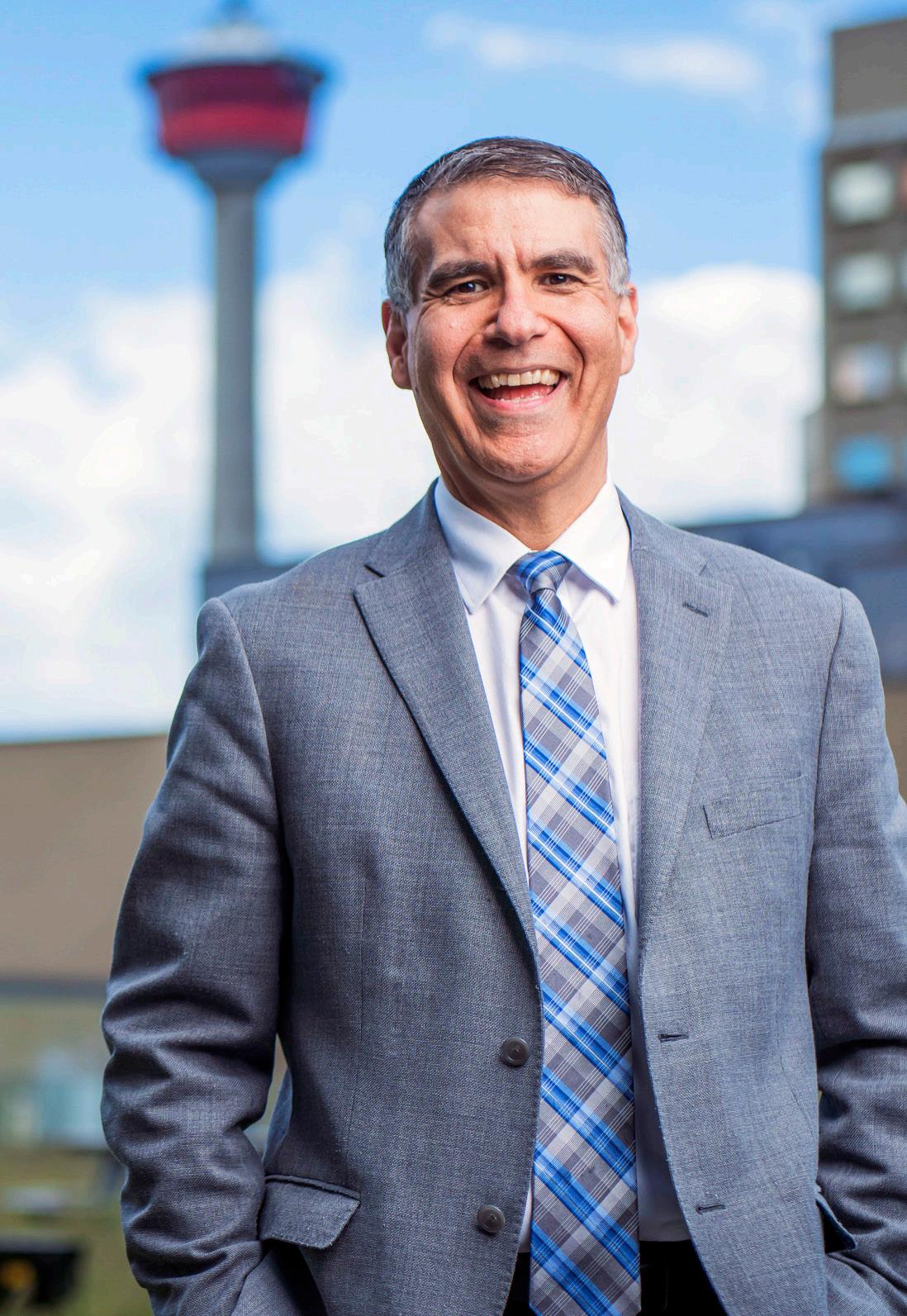
3. The customer care centre at Rümi is always home to highly engaged (and entertaining) employees.
4. At Mercer Peace River Pulp, employees are encouraged to support community initiatives via a $500 company donation for every 40 hours an employee volunteers.

Alberta is enjoying an economic renaissance, and while this is good news for employers, it also means the competition to attract new talent is fierce.
The competition is especially vigorous in the oil and gas sector, where drilling activity and oil production is jumping well above their levels of a year ago, according
to a recently released TD Provincial Economic Forecast.
But this year’s Alberta’s Top Employers competition shows that whether the jobs are in the oil patch or in urban centres, the most successful companies are relying on a multitude of smart strategies to engage and retain newcomers.

Richard Yerema, executive editor at the competition and also a best-selling
business author, has seen this shift first-hand. “The recovery of Alberta’s industrial sector has been remarkable, and businesses understand that flexibility, health plans and an overall emphasis on employee wellbeing are required to attract the best and brightest,” he says.
Such is the case at Inter Pipeline Ltd., a multinational petroleum transportation and infrastructure firm. Inter Pipeline is
responding to a growing trend of employees wanting to advance quickly within their place of employment.
“More than ever, people are looking for opportunities that enable them to grow their careers,” says Desmond Salisbury, Inter Pipeline’s general manager of human resources. “Fortunately, we’re well equipped to accommodate that, having an abundance of interesting work and
projects for those who want to challenge themselves.”
As for the familiar stigma of the oil patch being an undesirable workplace, Salisbury thinks it is largely a non-issue in 2023 and moving forward. “Concurrently we’ve developed an array of sustainable projects, which helps our standing as a desirable employer,” Salisbury says. “Our focus on sustainability is truly exceptional.”
Increased competition among employers is also changing how Alberta companies recruit and engage the talent pool.
Salisbury elaborates, “Instead of casting a wide net, which only works when the market isn’t hot, we’re taking a smart approach to recruitment. We’re doing a lot more work engaging our leaders to determine exactly what they need. From there, we undertake initiatives such as reaching out to different networks and being proactive to find the right people.” While it may not be a new trend, the need to give workers flexibility has become paramount to companies such as Fluor Canada Ltd. Stacy Posnikoff, human resources advisor for the engineering consulting company, points out that “Whether it’s Millennials or Gen X’ers, people have a lot of different needs, which is why we provide flexible start and end times as well as remote work and hybrid options.”
Posnikoff notes that new recruits coming out of the pandemic are exhibiting a desire for a strong sense of community and belonging; to respond to this change, Fluor maintains an array of staff groups, including an Emerging Leaders group, and it has also gone to considerable lengths to augment its physical workplace with amenities such as free parking, free gym and in-office yoga sessions. “All of this is capped by an abiding focus on diversity, equity, and inclusion,” she says.
Posnikoff cites another element that makes a big impact in Fluor’s workplace desirability. “Our management is incredibly approachable,” she says. “All of these initiatives contribute to our on-going goal of staffing up with critical thinkers.”

As Alberta’s economic recovery continues, the care exhibited by companies such as Fluor and Inter Pipeline not only give them the edge on recruitment but also help ensure that the right people are selected for the right job.
 – Robin Brunet
– Robin Brunet
Amy Maconochie joined Agriculture Financial Services Corporation (AFSC) to fill a position she couldn’t have learned about through her business diploma.
“Being a claims adjuster is more about learning through experience,” says Maconochie, a senior claims adjuster working out of the Red Deer branch office. “I’ve seen a lot in my three and a half years here!”
A job posting for a claims adjuster trainee to work on farm inspections seemed like an interesting opportunity to Maconochie, who grew up on a farm east of Lacombe. Now she is the youngest AFSC senior claims adjuster in the province.
“AFSC wants team members who have joined the organization to stay with the organization,” says chief people officer Melanie Ducholke. “We aim to create opportunities for members to experience different parts of what we do in our business.”
AFSC’s network of 38 branch offices across Alberta provides insurance and loans to agriculture producers. At the central office in Lacombe, just north of Red Deer,

team members work in a range of departments including finance, digital services and marketing. Many AFSC employees are also producers, so they understand the challenges and rewards of farming.
Ducholke is an example of someone who has found a home in the organization. Most of her 26 years of experience are on the business side of AFSC, but she worked with her leaders to develop a career path in human resources. Along with her studies,
Ducholke did “stretch projects” to gain skills and experience outside of her traditional job description, so when opportunities arose, she was ready.
“AFSC is proud to provide career growth and opportunities for team members,” she says.
The organization also supports employees’ career plans through virtual collaboration.
“An advantage of a virtual work option is that some team members whose job would typically have
been at central office are now able to stay in their communities,” says Ducholke. “They can continue to work their farming operations and fulfill their career goals here.”
During the pandemic, AFSC created a culture committee to connect people from various physical locations to one virtual setting. As a medium to large-sized employer, this is one way they maintain the feeling of a small, community-based organization.
The culture committee oversees
“To me, AFSC is more than a traditional business. There is a greater community focus to what we do.”
— Melanie Ducholke Chief People Officer
a number of initiatives, including a “sowing support” mentorship program that matches employees across the organization for learning and relationship building. There is a weekly virtual fitness program to help with mindfulness and stress management. And a financial aid program is available


to support employees who may experience tragic circumstances such as needing help with medical expenses for a sick child.
There are also employee resource groups organized by employees with common interests, such as women, young people and parents. The senior leadership
team is able to tap into these groups to design programs especially for them.
Maconochie has found her colleagues work well together and everyone is more than willing to lend a hand. When she first started as a senior claims adjuster, her supervisor was there every
step of the way, showing her how he performs inspections. Now Maconochie is confident she has the skills to work effectively with community producers.
“To me, AFSC is more than a traditional business,” says Ducholke. “There is a greater community focus to what we do.”
The pandemic sparked a dramatic shift in the way people work and it’s one that many organizations, including Alberta Blue Cross, believe is here to stay.
“Alberta Blue Cross always supported flexible work arrangements, even prior to the pandemic,” says Mark Razzolini, vice-president of people, wellness and innovation. “Therefore, we did not resist the changes in work styles that occurred during COVID and we’ve really embraced the new hybrid work environment.”
Like many employers, Razzolini says Alberta Blue Cross learned during the pandemic that people could be just as productive working from home as from the office; in fact, sometimes productivity increased.
At the same time, many employees found that the flexibility of working from home resulted in an enhanced experience, allowing them to better balance their work and personal lives.
“I think people really started to re-evaluate what’s important to them during the pandemic,” says Razzolini. “For example, not
having to commute every day gave them more time to spend with their families and friends as well as more time to pursue their individual interests and wellness.”
Based on the type of work they do, as well as their personal preferences, Alberta Blue Cross has tried to provide as much flexibility in work styles as possible. As a result, 54 per cent of the organization’s nearly 1,300 employees currently work from home full-time, while another 40 per cent pursue a mix of remote and in-office work. Only six percent are working full-time on site.
Alberta Blue Cross has taken
that flexibility to another level, allowing some employees to work out-of-province entirely if that meets a particular need, such as being closer to extended family.
With more than 1.8 million members, the not-for-profit Alberta Blue Cross is the largest health and wellness benefits provider in the province and one of the largest in Western Canada.
Razzolini says the organization’s recent embrace of a hybrid work model is very much in keeping with the organization’s core social purpose, which is to “empower people to live their best life.”
That core purpose also drives
the organization’s community investment initiatives. Hearts of Blue, an employee-led charity, provides support to community organizations across the province. In 2021, employees raised $41,000, which was matched by the company and then split among 41 charities.
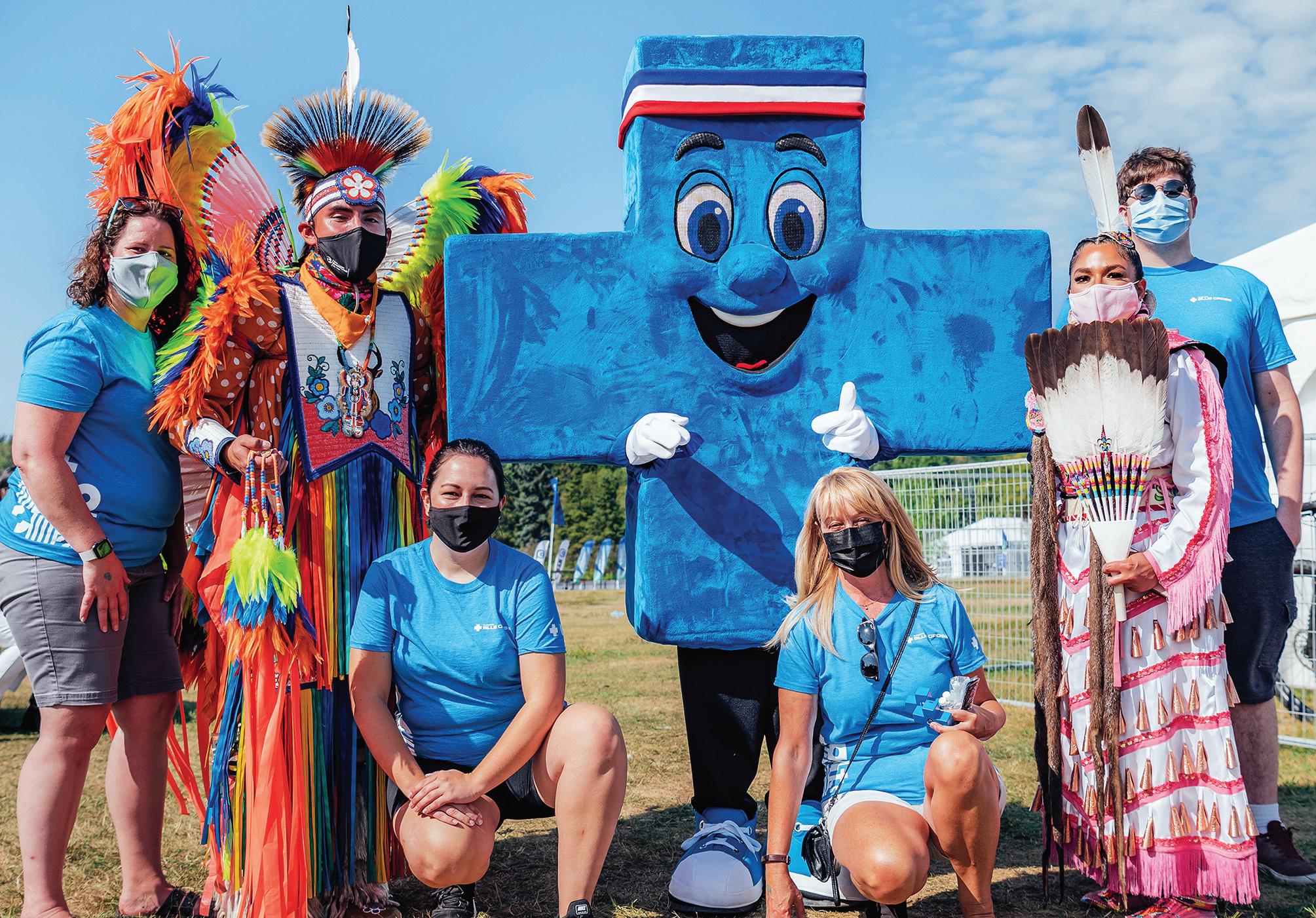
Kelle Cloutier, who joined Alberta Blue Cross as a graphic designer in 2019 and is now also chair of the staff association, says she appreciates the way the organization has supported more flexible work arrangements.
While Cloutier now works 90 per cent of the time virtually,
“I think people really started to re-evaluate what’s important to them during the pandemic.”
— Mark Razzolini Vice-President, People, Wellness and Innovation
1,260
49 100%
21,642
full-time employees in Canada years, longestserving employee educational assistance up to $4,000 annually job applications received last year
she also looks forward to the events that help keep employees connected.
“We had an evening picnic earlier this year at the University of Alberta’s botanical gardens near Devon,” she says. “It was one of the first opportunities we had for employees and their families to
gather together and mingle since the pandemic began.”
Cloutier also appreciates the many ways Alberta Blue Cross gives back to the community.

“Whether it’s donating money for Indigenous scholarships or helping to build accessible playgrounds for people with disabilities
or volunteering at women’s shelters, I’m really proud to be part of an organization that has such a positive impact on the community,” she says.
As the more flexible work arrangements evolve, Razzolini says the organization is putting a renewed emphasis on leadership

development aimed at helping team members navigate the new hybrid work environment.
“We are focusing more on actual outcomes, rather than when or where people are working,” he says. “We want to make sure we are setting people up for success.”
Headquartered in St. Albert, Alberta Gaming, Liquor and Cannabis (AGLC), is the Government of Alberta’s Crown enterprise that oversees the gaming, liquor and cannabis industries in the province.
In her tenure as a policy analyst for AGLC, Heather Fitzpatrick has supported policies and procedures governing all three industries, including Alberta’s unique charitable gaming model.
Alberta is the only province in Canada where charitable organizations are licensed to conduct and manage casino events. AGLC also licenses charitable organizations to fundraise through bingo and by selling raffle and pull tickets.
Beneficiaries include everyone from food banks and seniors’ groups to eligible amateur sports and performing arts organizations.
“We’re always working to ensure our policies support stakeholders and make things accessible,” says Fitzpatrick. “Ultimately, the goal is to support communities and charitable groups while maintaining safety for Albertans."
AGLC’s core values are integrity,
respect, collaboration, innovation and inclusion. That last value is one that was added as part of an overarching commitment to diversity and inclusion.
Fitzpatrick, a 25-year AGLC employee, is also co-chair of an employee resource group that organizes a series of awareness campaigns and learning events focused on diversity and inclusion.
“Our stakeholders rightfully have high expectations,” she says.
“Because of that, we are constantly evolving, and our values have evolved with us. It’s really exciting to see the corporate commitment
to growing not only our business but also our culture and people.”
CEO Kandice Machado says AGLC’s core values are built into every aspect of the organization’s activities, including recruitment, employee recognition and leadership development.

“It’s important that it starts from the top, making sure our leaders really embody our values on a daily basis,” she says.
Machado is another tenured AGLC employee, having joined 20 years ago as a regulatory auditor and moved through a number of increasingly senior roles, including
chief financial officer.
“Through it all, I’ve benefited from a tremendous range of training, coaching and mentorship,” she says. “To get to where I am now, I’ve definitely had a strong support system from leaders, colleagues and teams.”
Machado describes AGLC’s culture as innovative, customercentric and collaborative.
“We work with very diverse stakeholders and on complex business challenges,” she says. “So what I’m often looking for in new team members are people willing to live a little outside their comfort
“Ultimately, the goal is to support communities and charitable groups while maintaining safety for Albertans.”
— Heather Fitzpatrick Policy Analyst
zone, who don’t just settle for the status quo, and who look for new ways to support our partners and each other.”
During the pandemic, AGLC’s inspectors, gaming technicians and other field staff have, by necessity, continued to work on site. Office employees, however, worked
remotely and continue to have the choice to do so.
“We are assessing different hybrid models,” says Machado. “We want to see what works best over the long term for both keeping our culture strong while giving employees maximum flexibility.”

To help keep all employees
connected, Machado hosts regular virtual town halls, with plenty of time for Q&As.
Organized social events and charitable initiatives also keep AGLC team members highly engaged. For example, AGLC employees are longstanding and passionate supporters of the

United Way; in 2023, it’s expected they will reach the milestone of having raised more than $1 million for the charity.
“That’s very much an employeedriven effort,” says Machado. “It’s an example of positive collaboration and one we are very proud of.”

Providing choices and opportunities to support a more vibrant Alberta. Kandice Machado, CEO, at AGLC.
“We’re working on the challenges not just of today’s technology and innovation, but 30 years or so into the future,” says Laura Kilcrease, CEO of Alberta Innovates (AI). The provincial crown corporation invests in research, innovation, and entrepreneurship to boost economic growth and diversity. A focus on what’s next drives AI’s concentration and impact in such areas as moving towards a lowcarbon future and embracing the future of work itself.
A year ago, the company rolled out its unique flexible workplace option, re-imagining how diverse individual preferences can be balanced with business deliverables.
“Choose How U Work offered employees choices that are both practical and innovative,” says Kilcrease.
The program taps into each employee’s entrepreneurial spirit to continue the success of remote work, while encouraging creative exchanges when teams come together for collaboration days. Opt-in components allow each employee to personalize where and how they work.
The emphasis on innovating within core processes applies to all aspects of the employee experience
beyond this new model of work.
Kilcrease says she and her team are committed to maintaining ongoing engagement and communication, so everyone understands the important role they play in the agency’s purpose as the province’s innovation engine.
Introduced pre-pandemic, Coffee with Kilcrease gained impact as a virtual gathering for remote employees to connect informally with the leadership team during a 30-minute monthly session.
“They can ask us any questions – from what’s going on in the political environment to what’s my favorite pizza,” she says.
This augments a suite of
channels and tools used to keep information flowing and timely. A dedicated employee intranet spotlights employee accomplishments, business townhalls are held online, e-blasts go out weekly and employee-led lunch and learns happen often.
Kilcrease says that in a hybrid work environment, her team emphasizes checking in with employees. Employees described as Pacesetters are those throughout the organization who personify its values and draw the connections between big-picture goals and specific jobs and assignments.
“We rely on Pacesetters to raise the things they’re thinking about
in the next five years,” she says. “We are intentional about creating a culture of openness with our employees.”
A key part of this culture is how the five C values – collaboration, creativity, can-do spirit, commitment and curiosity – are embedded into the everyday. A recognition program that allows employees to send digital cards to spotlight great work has been key in cultivating an attitude of gratitude and acknowledgement.
Brian Eaton, manager of the environmental impacts team at InnoTech Alberta, AI’s applied research subsidiary, also points to opportunities for professional
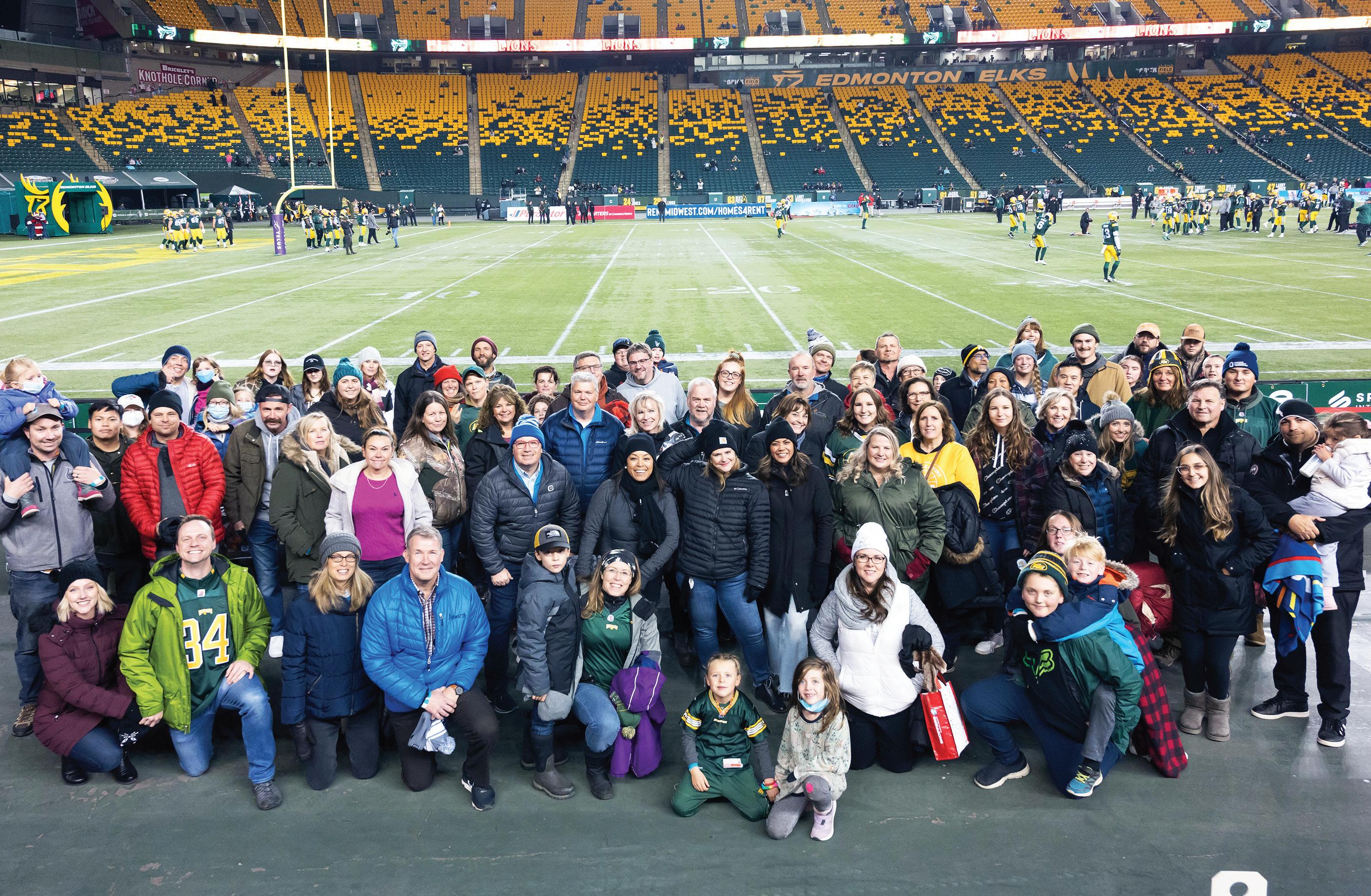
“Our game changers are making a difference to the province.”
— Laura Kilcrease CEO
development. They range from subsidies for degree courses to online course offerings, as well as bringing instructors in to give exclusive courses to employees.

Eaton talks about how 20 of his colleagues are receiving project manager training through this program, to improve the efficiency
of their projects on the job and in real time.




Beyond opportunities for strengthening skills in a specific field, he says, he’s enthusiastic about how InnoTech can share research and communicate across specialties.




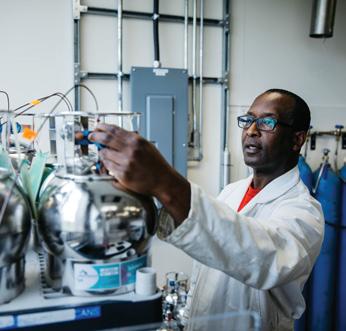

“I think that speaks to the
opportunities that are here – to be creative in your own field, to build these networks across multiple organizations and disciplines, and to just have fun,” says Eaton.
Across AI and its subsidiaries, Kilcrease and her team are making shared purpose a powerful unifying force that combines talents
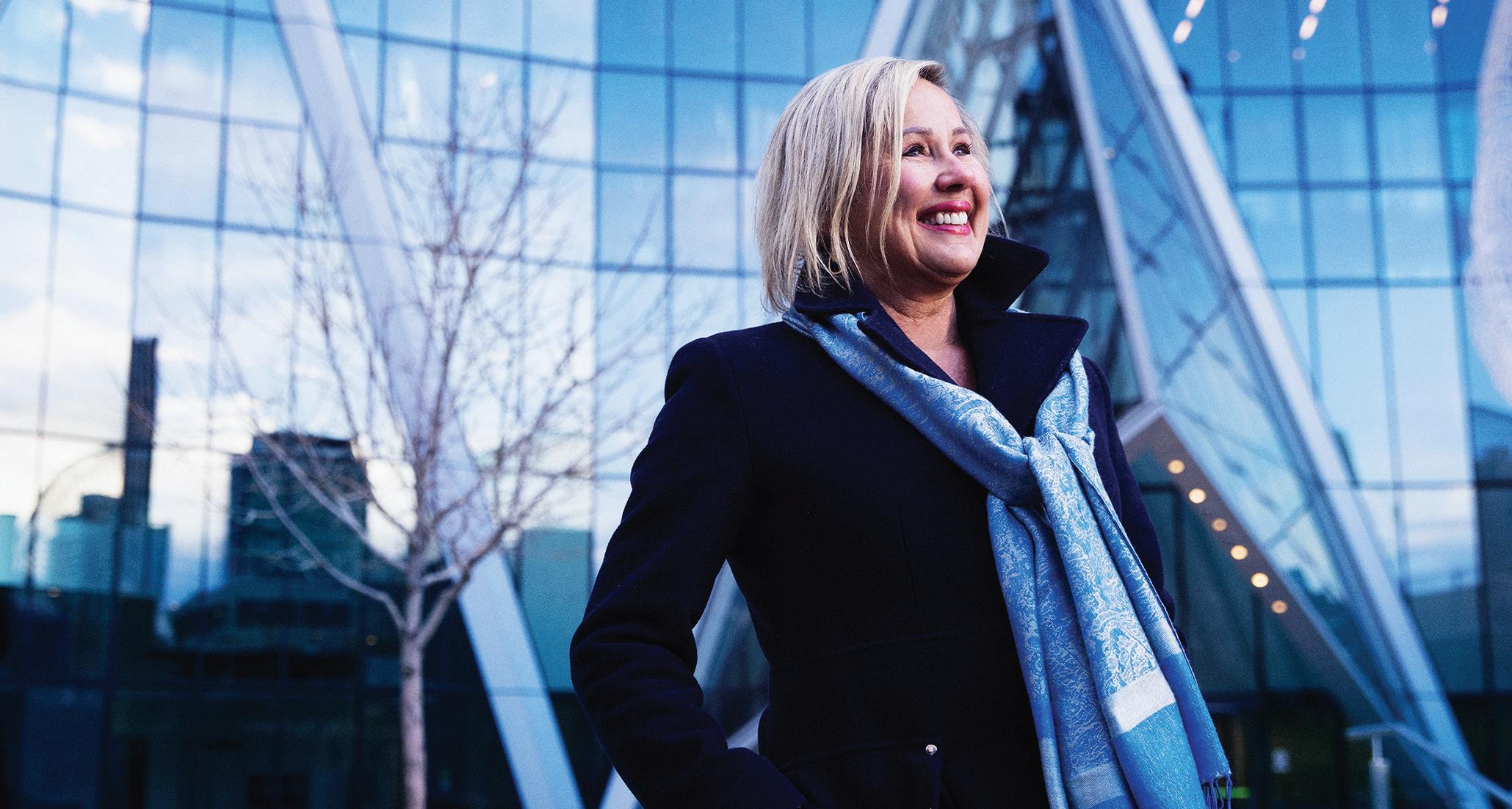






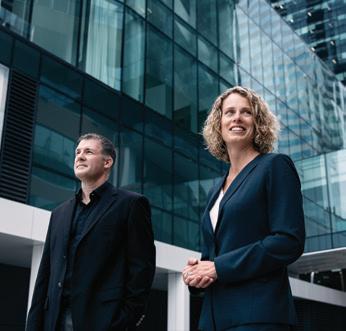
and strengths, forges connections across departments, seeks out synergies and shapes the future.
For Kilcrease and AI, that future looks bright. “We describe our employees as game changers,” she says, “and we do it for a reason –our game changers are making a difference to the province.”
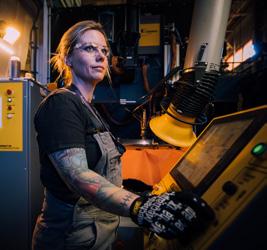




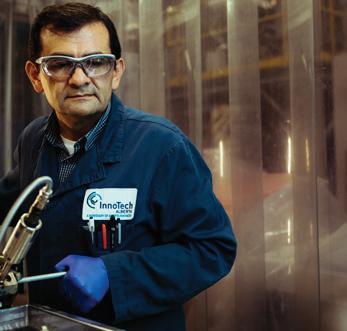
Christopher Osomo says he had his sights set on Alberta Pensions Services Corporation (APS) for several years before he started working there. Indeed, he could even see APS headquarters from his home in southwest Edmonton.
DarwinThe proximity was intriguing. But what he really wanted was the opportunity to make better use of his degree in business and commerce than he’d had in jobs to date. Osomo says he was also attracted to APS’s reputation as a values-driven employer that supports its people in meaningful ways.
So, when the opportunity arose in 2016, he joined the Crown corporation – and has been in his element ever since. His responsibilities as a member services representative include fielding a wide variety of questions from current and retired public sector employees about their pensions.

“I love to talk and I particularly love to talk about pensions,” Osomo says. “I feel it’s a privilege to make sure our members have
the information they need to make informed decisions.”
Founded in 1995, APS provides pension administration services for more than 500 public sector employers in Alberta, including municipalities and hospitals as well as various provincial bodies. Administering about $6 billion in pension funds annually, APS also provides pension-related services to over 370,000 members and pensioners.
Darwin Bozek, president and CEO, says that as an organization that administers pensions on behalf of its clients, APS doesn’t have a prominent public profile. Still, he’s not surprised when new hires say they first heard about
the organization through word of mouth.
Many are attracted to how the organization embodies its mission and values of service excellence, quality and accountability, Bozek says.
“We are a caring organization,” he says. “We care about the important work we do and we care about the people who do the work.”
That attitude is reflected in how APS prioritizes employee growth and professional development, says Tamara Janzen, vice president, human resources and organizational development. She speaks from experience.
“I wasn’t a vice president when I
started here in 2011,” Janzen says. “But somebody saw something in me and made sure that I received the mentoring and training that I needed to move ahead in my career.”
APS offers employees a variety of educational opportunities, both on site and through external learning programs. She adds that in addition to a formal career development program, managers are being equipped to incorporate regular career development discussions into weekly employee one-on-one sessions. That helps keep people on track whether they want to advance or transfer as their career evolves.
APS also has initiatives to
“We are a caring organization. We care about the important work we do and we care about the people who do the work.”
—
Bozek President & CEO
maintain a collegial, engaging work environment, Janzen says. In addition to an employee-led committee that organizes various activities to create staff connections and support diversity, equity and inclusion throughout the year, the organization hosts such events as regular townhalls, online

activities and a holiday luncheon. When the majority of employees were working from home during the pandemic, some get-togethers were held virtually. Despite their limitations, says Janzen, the virtual events still helped employees feel connected.
“In 2022, when we held in our

first in-person summer barbecue in two years, it was like a big family reunion – everybody was so happy,” she adds.
APS has since adopted a hybrid model and, like other employees, Osomo works primarily at home and with some days in the office. The way APS has taken care of

employees’ health and well-being throughout the pandemic is the latest addition to a long list of reasons why he says he appreciates working there.
“I’ve always felt listened to, that my ideas and contributions are valued,” Osomo says. “It’s been everything I expected and more.”
In both life and at work, Sizani Maphosa has sometimes struggled with being accepted for who she is. But in eight years with the Alberta School Employee Benefit Plan (ASEBP), that has never been an issue.
“In society, I’ve sometimes felt I had three things working against me,” says Maphosa, ASEBP’s supervisor of benefits. “I’m a woman, I’m Black and I’m an immigrant. But at ASEBP, I’ve always felt I belonged, that they accepted me as I am and they valued me. That means a lot.”
Maphosa says that kind of acceptance and support is embedded across the organization and helps inform how she now deals with those who report to her.
“The support I’ve had from leadership here has helped me learn and grow, not just as an employee, but as a human being,” she says. “Because of the way that’s been modelled to me, I am now that way with my own team. By listening and letting people know that everyone has a voice, we help build a strong team which
provides a valuable service to our members.”
Founded in 1968 by the Alberta School Boards Association and the Alberta Teachers’ Association, the not-for-profit ASEBP provides insurance coverage, health programs and services to the province’s public education sector.
The ASEBP culture begins at the point of recruitment, says CEO Kelli Littlechilds. The first round of interviews is typically about sorting out those who have the technical skills to do the job at hand. From that short list, it’s
about finding people who are a good fit for the organization.
“We are looking for people with integrity, who believe in the importance of collaboration and who share our values, including a strong commitment to diversity, equity and inclusion,” she says.
The pandemic ushered in a sea change for how ASEBP’s workforce operates. After nearly two years of working almost entirely virtually, the agency fully embraced a hybrid work model beginning in May 2022.

ASEBP looked at every single
position to assess how much time employees might need to be in the office. Based on that, as well as individual preferences, the organization now offers a flexible set of work options, which ranges from some people being in the office as little as one day a month to some employees who choose to work five days a week in-person.
Littlechilds says the last few years have been revelatory in terms of showing employers different ways to get the required work done productively.
“Pre-pandemic, we all knew how
“The support I’ve had from leadership here has helped me learn andgrow, not just as an employee, but as a human being.”
— Sizani Maphosa Supervisor of Benefits
to work in the office five days a week,” she notes. “Then, when it was all virtual, we figured out how to do that, without skipping a beat in terms of customer service. Now, this new hybrid model is showing us how to have both a highperforming workforce and the kind of work-life harmony we
couldn’t have imagined just a little while ago.”
Whether virtual or in-person, ASEBP continues to focus on employee wellness. That was recognized by two awards for excellence the agency received in 2022 from Benefits Canada for organizations with less than
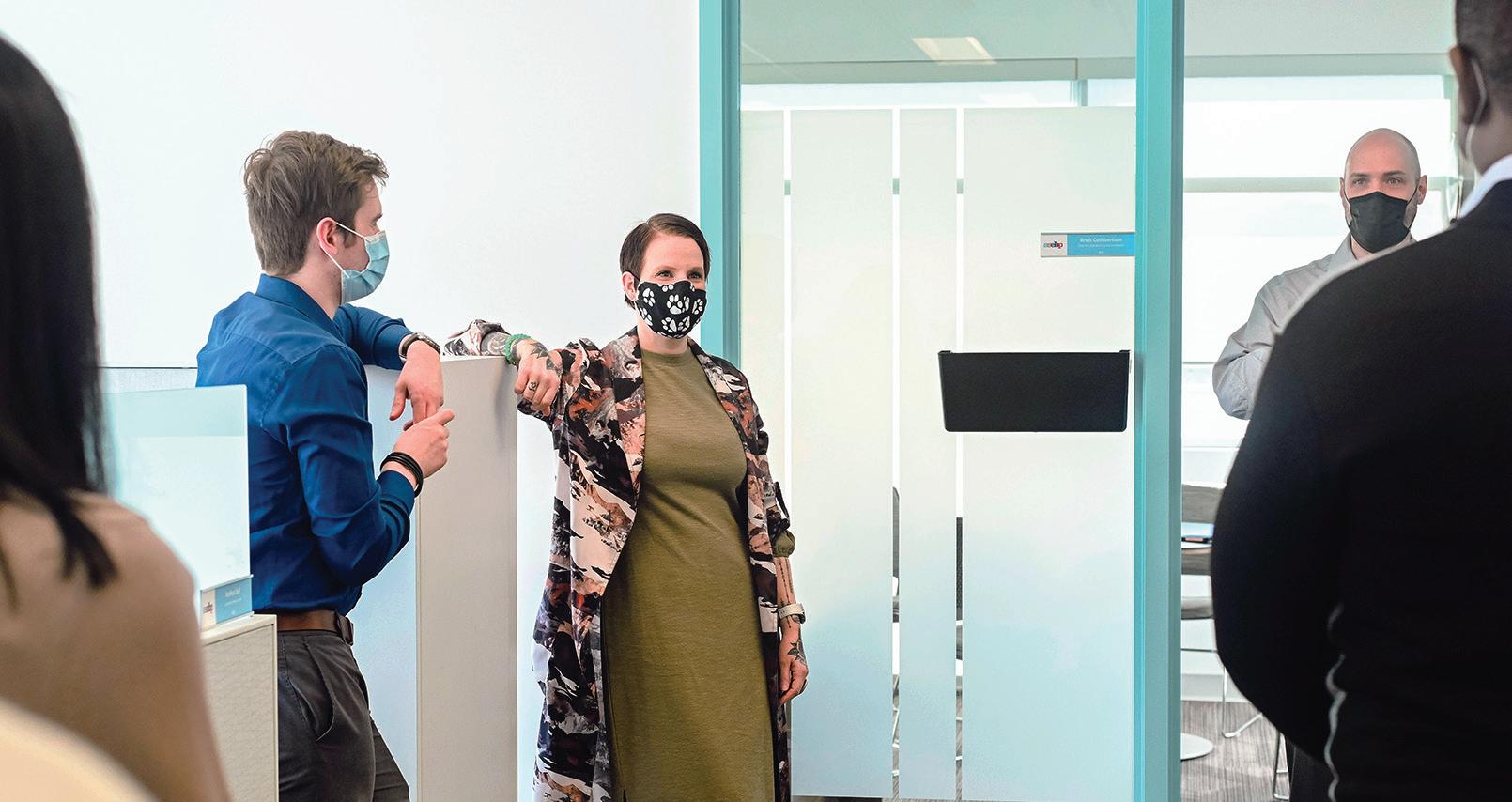
1,000 employees.
The first award was for developing innovative and effective strategies for managing benefits and supporting employees during the pandemic. The second recognized ASEBP mental health programs that support and encourage the psychological
well-being of employees. For Littlechilds, who joined ASEBP as a receptionist 39 years ago at the age of 18 and has been its CEO since 2017, those awards are further evidence that the organization’s workplace culture continues to thrive, even in dramatically changing times.

Our dedication to Alberta’s public education sector is reflected in each of our caring and talented employees.
Thank you for all that you do! ASEBP offers a flexible set of work options with a continued focus on employee wellness.
When Jocelyn Venechuk was studying for a bachelor of science degree in business operations 20 years ago, she had to write a business profile of a Canadian company for one of her courses. After reading a magazine article about Calgarybased ATCO Group, she chose to profile the company that would one day employ her.

ATCO is a diversified global corporation with investments in the essential services of structures and logistics, utilities, energy infrastructure, retail energy and commercial real estate. “It’s hard to grow up in Calgary and not know about ATCO,” says Venechuk. “That article left an impression with me that it would be an interesting place to work, because while it cares about the bottom line, it cares about other factors, too.”
In 2017, Venechuk joined the organization as a proposal specialist, and within her first year she became communications lead for the Employment Equity Advisory Committee. “Our equity program needed an update and a focus, and as a relatively new employee, I was eager to participate,” she says.
The committee soon realized it
needed more input from employees around equity issues. Venechuk, who identifies as racially diverse (both of her parents are from the Philippines, and her father is half Chinese), was enthusiastic about soliciting feedback. “We’re the voice of employees from all levels of the organization, not just leadership, but we’re supported by our senior leaders,” says Venechuk. “We take the work that we do very seriously.”
The committee continually surveys employees to give them the opportunity to self-identify as under-represented groups, to help get the full picture of whether they feel they belong at ATCO and what the organization could be doing better. “I’ve noticed there’s a great intent and response to the data that’s collected,” says Venechuk. Examples of initiatives include stronger, more sustainable partnerships with Indigenous communities and greater support
for women’s career paths. While Venechuk is listening to what others have to say, she also appreciates that others listen to her, too. “They aren’t afraid of pilot projects here, and many of my ideas have been implemented,” she says. “I have a hybrid role now, and I receive recognition for it – ATCO allows employees to say where they feel they can add value.”
That kind of comment pleases
Deanna Girard, vice president
“ATCO is aboutcreating a better
world,which aligns with my personal values.”
— Deanna Girard Vice President, Human Resources
of human resources. She joined ATCO in 2014 as director of human resources, attracted by the sense of broader purpose behind the business, the diverse career opportunities and the global business model that extends far beyond Alberta’s borders.
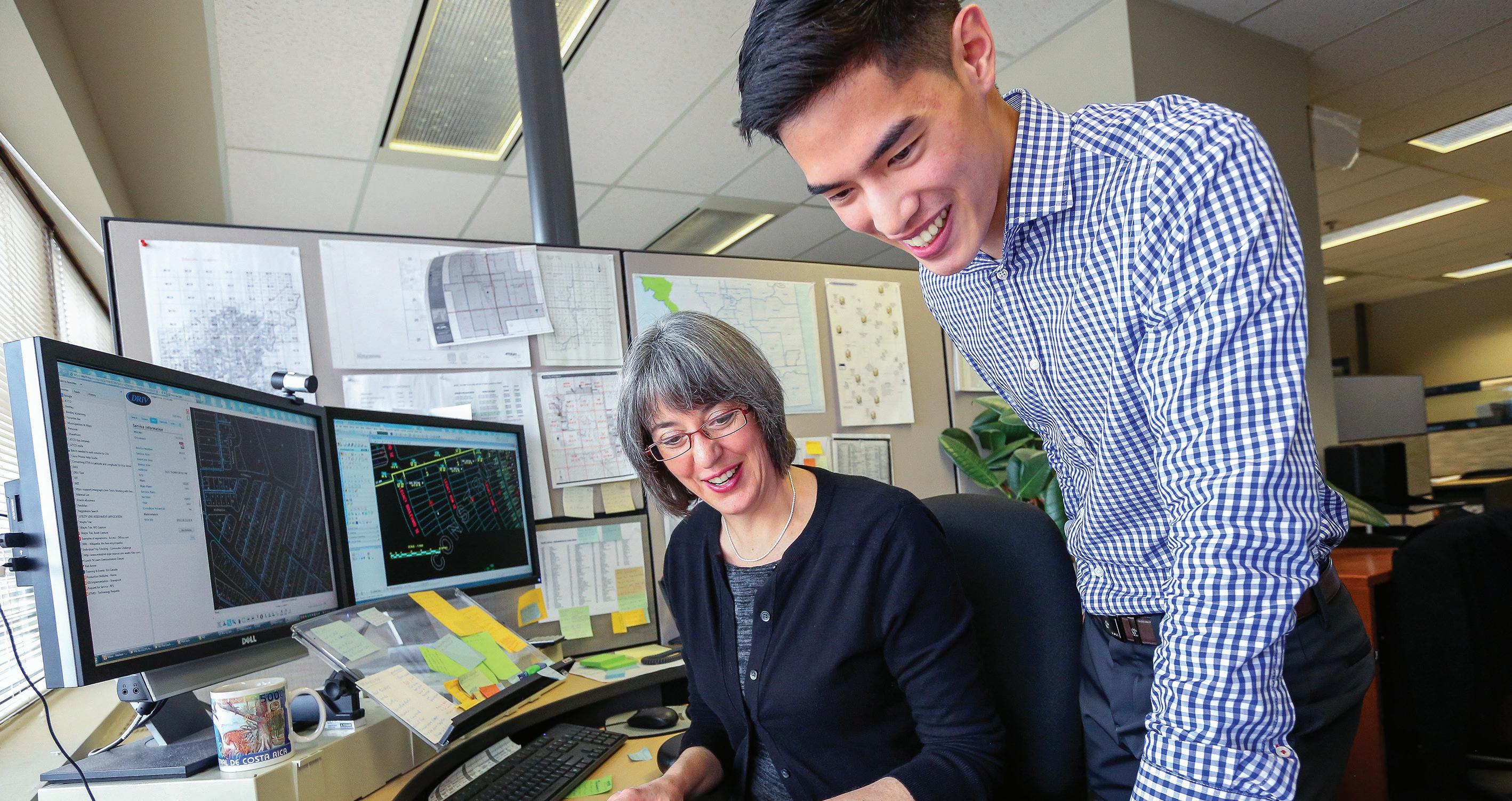
“ATCO is about creating a better
world, which aligns with my personal values,” says Girard. “I love working here because it feels good – it feels right. Our value of caring is core to who we are and has been since day one.”
Girard says that some members of the ATCO team in Alberta illustrated that caring nature when

they hosted refugee families from Ukraine in their homes. “At our town halls, our CEO thanked all of the employees who have taken this action to support newcomers in their communities, demonstrating the depth and breadth of caring at ATCO,” she says.
Through a program called
Employees Participating in Communities (EPIC), employees donate funds to not-for-profit charities of their choice. In 2021, almost $3 million was raised globally. “It’s a reflection of our values that our people give to the communities they serve,” says Girard.
When Kory Hill says he never has a typical day on the job, it’s only partly in jest. As manager, mechanical, with Canadian Pacific (CP) in Lethbridge, he leads a team of five supervisors and 46 employees responsible for ensuring that the trains passing through continue their journey in good working order.
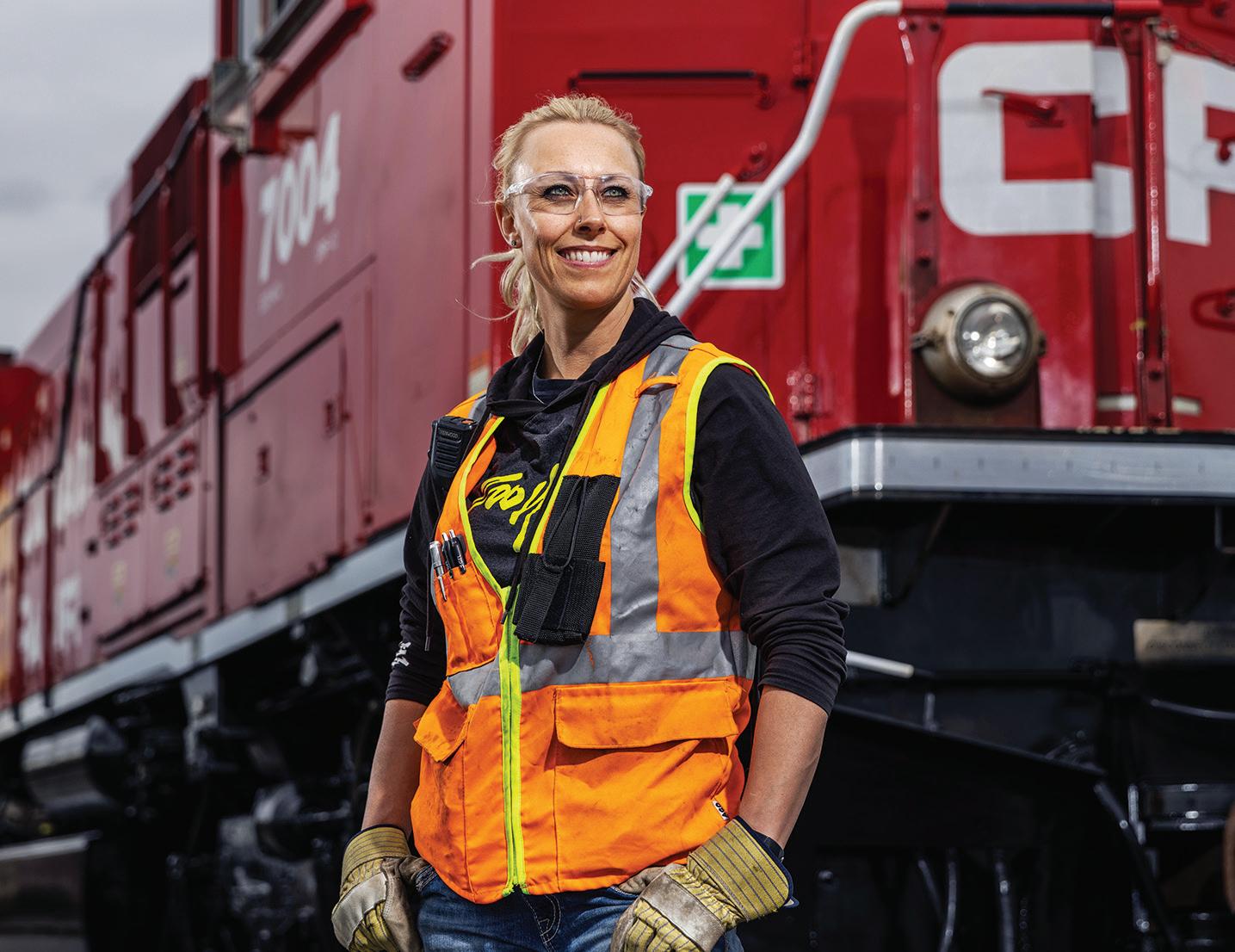
Lethbridge is a critical terminal supporting CP’s bulk franchise, inspecting and performing maintenance on freight cars and locomotives. What’s more, while many Alberta terminals serve either CP’s east-west or north-south corridors, the lines converge in Lethbridge where crews shepherd trains to and from all four directions.
“The team wears a lot of different hats,” Hill says of the range of duties they undertake in three eight-hour shifts a day, 365 days a year. “It takes a lot of organization and communication to keep everybody safe and all the traffic moving efficiently.”
Completed in 1885, the railway physically united Canada, and CP has played a significant role in the Canadian economy ever since. Today it offers freight transportation services in both Canada and the United States.
Some tasks, such as visual inspections to identify necessary repairs, would be familiar to earlier generations of railroaders. But current employees also have the advantage of 21st century technologies, robotics and data analytics for everything from logistics planning to predicting equipment failures before they occur.
Hill has become familiar with CP’s established and emerging procedures only since 2018, when he joined the railway as a
mechanical supervisor. Until then, he’d worked in the oil and gas industry, but switched sectors with the help and encouragement of a family friend familiar with CP.
Two years later, Hill was promoted to the manager’s role. While taking some CP leadership training programs he also met colleagues from different communities and on different operational and professional career paths. Some, Hill says, have become unofficial mentors.
“I’m not afraid to say ‘I don’t
know,’ and there are people throughout Canada I can turn to for advice,” he says. “I’ve never had anybody not take a call.”
According to Pam Arpin, vice president and chief information officer, making connections and facilitating communications is nothing new for CP. “It’s what we’ve been doing since the 1800s when we ran telegraph wire alongside the tracks,” she says. “Our culture has always been forward-thinking.”
Like other senior leaders, Arpin
“Our culture has always been forward-thinking.”
— Pam Arpin Vice President & Chief Information Officer
10,360 80% 6 569
full-time staff in Canada of the Canadian board of directors are women weeks, maximum vacation allowance charities helped last year
hosts regular town hall meetings, which became increasingly important during the pandemic when employees were working from home. CP has since adopted a flexible, hybrid workplace model and encourages people to return to the office when feasible so they can interact and collaborate in
ways that aren’t possible through a computer screen, she says.
Arpin herself has extended an invitation to the 900 employees on her team to join her one-onone on her frequent 30-minute walks around the park-like grounds of the Calgary head office. Those employees include
IT professionals who design and implement many of the complex technologies that make CP a rail industry leader in innovation. CP believes diverse thinking drives innovation and is committed to supporting a representative and inclusive workplace, Arpin says. So when the


League of Railway Women named her Railway Woman of the Year in 2019, it inspired her, she says, to become more active in encouraging young women to enter historically male-dominated fields like railroading and IT.
“You can be what you can see,” says Arpin.
Apply today at cpr.ca/careers

When Lorelei Yeboah started working in canola seed research right after university, she wasn’t sure where her career might be heading. Over the past 14 years, Yeboah has undergone several major job shifts, but she is still employed at the same company, Calgary-based Corteva Agriscience Canada – and she believes there’s a good reason for that.
“Every time I’ve needed a challenge, I’ve been given an opportunity,” says Yeboah, who moved from research to commercial to marketing and communications before landing in her current role as portfolio marketing manager for pre-seeds, herbicides and third-party tech sales. “I’ve always felt I could grow, which is amazing. I’m really grateful that the company has given me the opportunity to do that.”
When she moved to the company’s Calgary head office from Saskatoon, Yeboah didn’t know anyone, but Corteva’s management took steps to help her settle in that ended up leading to
even more opportunities.
“The company was so supportive,” she recalls. “They suggested I get involved with the Women’s Innovation Network, one of Corteva’s diversity and inclusion groups. I eventually became president of that chapter for Canada, which opened so many doors. I got to travel to conferences, facilitate events and meet lots of people. What an opportunity! They really set me up for success.”
Vik Kail, Corteva’s human resources leader for Canada, says
that those professional development opportunities and diversity-focused networking groups are all part of Corteva’s emphasis on creating a positive work environment for its employees, who are spread across urban and rural sites in several provinces and came together in a merger of three different companies in 2019. Bringing everyone together in a modern workplace with harmonized policies was a challenge at first, Kail admits. “It took a while to get everything aligned, so
initially employees from the different companies had different benefits, work hours, leave and vacation policies,” he says. “But today we feel like one team and that’s really due to the work of our people leaders.”
Corteva offers employees a range of job enrichment and development programs as well as webinars, speaking series and town halls to connect far-flung colleagues. They also receive a generous retirement savings plan, 23 paid vacation days starting in
“There’s an openness and trust here that I don’t think you get in every company.”
— Lorelei Yeboah Portfolio Marketing Manager
their first year and an employee stock purchase plan. But Kail maintains it’s really about the direct connection between staff and management.
“Nothing can impact an employee’s day-to-day experience more than their immediate team,” he says. “I think the most tangible
benefits come from one-to-one feedback from their manager, and we strive to do it with trust and transparency.”
Yeboah values the open-door policy of Corteva Canada’s senior leadership, including its president, Bryce Eger. “Bryce carves out time every week for


anyone who wants to pull him aside, and that’s huge to me, because how many companies’ leaders do that? There’s an openness and trust here that I don’t think you get in every company.”
She also appreciates the company’s flexible work hours,
health reimbursements for things like gym memberships, the employee stock purchase plan and free training, not to mention social events and potluck lunches. “I’ve been approached by other organizations, but I’ve never wanted to go,” she says. “Why would I?”
The soundtrack of Mary Fajardo’s working day at Enbridge Inc. has the intense hum of people who are hard at work, mixed with the constant refrain of laughter from her fellow employees who enjoy what they do.
“We do little things that add a bit of fun and brightness to our day,” says Fajardo, senior advisor, pension financial reporting.
“This is the first job where I have laughed so much, but we’re also so productive. It makes me excited to come into work every day.”
Enbridge is headquartered in Calgary and operates across North America. As an early investor in renewable energy with a growing wind and solar portfolio, the company safely connects millions of people to the energy they need.

Fajardo’s job connects her with the wide range of employees and leaders in the company in its multiple offices from Brooks to Edmonton and beyond. But wherever she goes, she experiences the same friendly, open and collegial workplace atmosphere.
That family-oriented corporate culture is built on Enbridge’s core values of safety, respect, integrity
and inclusion. Melissa Moye, chief human resources and inclusion officer, says those values aren’t just words on paper.
“Enbridge makes sure we have programs that our employees can access to build awareness around each of those four values and live them,” she says.
“They’re the foundation of our holistic approach to the overall wellness of our employees. We look at their total well-being, including physical, financial, social and mental health.”
Enbridge employees can earn up to $350 annually by participating in activities that support physical, financial, social or mental health. Work-life balance is a priority and the company offers employees a flexibility program that blends remote work with in-office days. Encouraging continual improvement and providing career growth opportunities keep employees engaged and energized. Fajardo appreciates the team approach the company takes in developing training modules and opportunities to
share her successes with her fellow employees. Enbridge’s recently launched Career Development Skilling Program allows employees to upskill for the position they’re in or determine what they need to succeed in a different job.
“Continuous learning unlocks the innovation and creativity of our employees,” says Moye. “It creates a culture where everyone feels they can give their best. It’s a catalyst for the company’s growing momentum and it’s what sets us apart.”
“I’m engaged every day because I’mmade
to feel important.”
— Mary Fajardo Senior Advisor, Pension Financial Reporting
7,384 51 2% 6
staff in Canada years, longestserving employee voluntary turnover last year weeks, maximum vacation allowance
While taking the work seriously, employees find ways to inject levity into their day. Teams compete with each other in online trivia contests, paper airplane distance competitions and step challenges. Active social committees provide employees with opportunities to network and build
connections outside of work. Enbridge and its employees also take to heart their commitment to the communities they operate in. Fajardo and her team have helped out at homeless shelters and taken part in the company’s Fueling Futures program, where their contributions can be matched

up to $5,000 per year for any combination of hours volunteered, special grants or funds donated.
Fajardo says she feels listened to as an employee. An open and accessible corporate structure allows her to feel comfortable approaching a manager or executive at any level with a problem or a

suggested solution.
“I’m engaged every day because I’m made to feel important,” she says.
“My leaders always make time to come and talk to me and ask me how I’m doing. They make me feel my welfare is just as important as their own.”
And we’re making it happen today. By bridging to a cleaner energy future. Always reaching higher on a pathway to net zero. And looking for the brightest minds to help get us there. Tomorrow needs you. Join one of Alberta’s Top Employers. Visit enbridge.com/careers. Tomorrow is on.™
Fluor Canada Ltd. has provided engineering, procurement, fabrication, construction and project management services to Canada’s energy industry for over 70 years. With a presence across the country, Fluor is committed to positively contributing to Canada’s energy tomorrow by focusing on safe and sustainable solutions today.
Employees like Marina Muenchrath describe Fluor’s work environment as having high energy and high innovation. Muenchrath, operations coordinator and professional electrical engineer, has been with the organization for over eight years.
“I was drawn to the company right out of university because I wanted to do technical work,” says Muenchrath. “Fluor has big teams doing complicated projects and working with such a broad range
of people with different knowledge sets, I learned things I never thought I would as an electrical engineer.”
Stressing innovation and sustainability, Fluor Canada has grown with the industry and diversified its offerings. The company provided a breakthrough in reduction of carbon dioxide emissions with the Shell Quest Carbon Capture & Storage project, among many other large-scale projects.
“We have created an environment where we hope that people bring the best of what they have – and then they learn from each other,” says Mark Brown, vice-president and general manager, Fluor Canada. “It all comes down to one of our core values – teamwork – people
helping others excel.”
Fluor provides opportunities for its employees to continue to learn and grow throughout their careers. These include Fluor University –an online portal with a catalogue of courses – employee resource groups, mentorship, conferences, customized programs and tuition assistance, to name a few.
“It’s been rewarding to learn other skills,” Muenchrath says. “It takes more than just engineering to run an engineering, procurement and construction company.”
Fluor Canada’s culture supports innovation, beginning with the workplace. There are collaboration rooms outfitted with the latest technology, and employees are encouraged to take a break to play foosball or chess or grab a coffee

at the in-house café.
During the pandemic, leaders also noticed how virtual teamwork seemed to help people remain resilient through the pandemic. There was a conscious commitment to wellness, and employees were encouraged to reach out and stay connected. Attention was paid to supporting camaraderie with virtual coffee breaks, birthday celebrations, team builds and more.
Outdoor group activities such as running, hiking and soccer began and still continue. Flexible working arrangements and a more business-casual dress code have also remained.
“Employees are supported not just to do their job, but also to think of different ways to do it,” says Brown. Fluor is involved in
“We have created an environment where we hope that people bring the best of what they have – and then they learn from each other. It all comes down to one of our core values –teamwork.”
— Mark Brown Vice-President and General Manager, Fluor Canada
1,361
2,682 48 100%
staff volunteer hours last year years, longestserving employee role-related tuition subsidies
investigations and study work on how to lower the carbon footprint of the local industry and promote technology that enhances future sustainability.
Employees engage in studies that support the current energy transition, alternative energy, solar panels or hydrogen as a future
power source. The company is also exploring renewable natural gas as well as working on several renewable diesel projects.
Fluor Canada and its employees take an active engagement role in the community in Calgary, Alberta and beyond. Working with local charities, Indigenous organizations

and school programs, Fluor supports diversity, equity and inclusion in all aspects of its business. Achieving a culture of inclusion and belonging results in a diverse, high-performing and innovative workforce.

“Our relevancy goes beyond building large-scale facilities,” says
Brown. “Fluor is a part of the communities in which we operate and build projects, and where our employees live and work. Ensuring we make an effort to build a better world, starting with our local environment, contributes to it being a place where people want to work.”
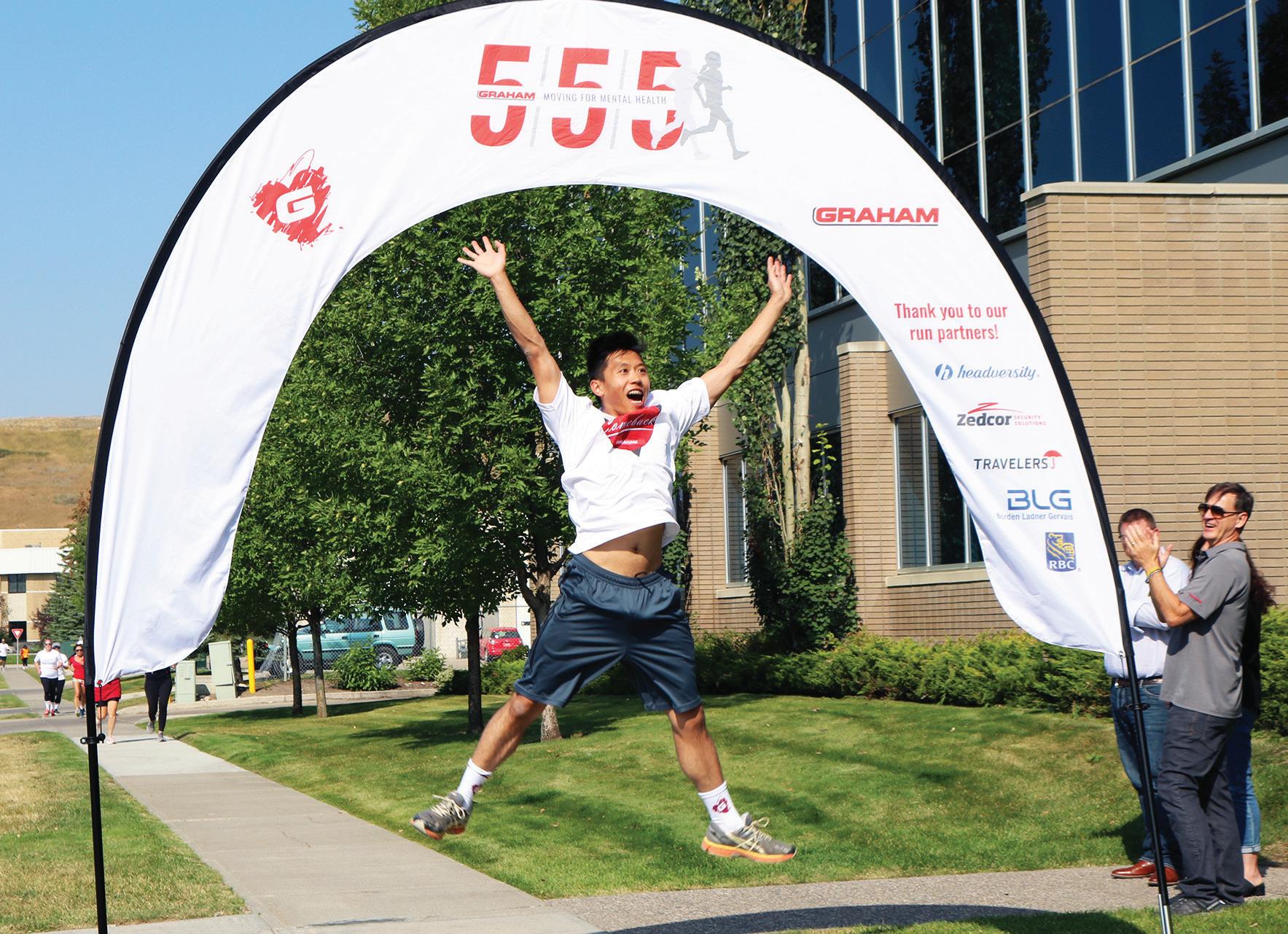
When Pauline Leclaire made a list of companies she wanted to work for, she included Graham Group, for several reasons.
A contracting company founded in 1926, with offices in 23 locations throughout Canada and the U.S., Graham operates in an industry that aligned with her ethical principles. With more than 2,200 employees, it was still much smaller than the multinational railway behemoth that laid her off after 15 years.
It also offered her an opportunity to contribute and make a difference. But most of all, she says, “Graham truly values people. It’s who we are.”
The organization has nurtured a culture that values respect, says Leclaire, now the company’s human resources director, talent management, even as it encourages individuals to live up to their capabilities. “There’s never a day when I haven’t felt that the company puts people first.”
One of Leclaire’s first assignments in 2015 was participating in the design of a program called the Builders’ Framework. A construction-focused project management initiative, the
program consists of 27 courses, from pre-construction to project completion, including scheduling, planning and contracts.
“It teaches people to build the Graham way,” she says.
As a former teacher, Leclaire worked on technical writing and designing the courses, while the content was provided by experts in the field.
Participants receive Gold Seal credits from the Canadian Construction Association and professional development units from the Project Management Institute.
After working on leadership
development and other programs, ensuring that the company “promotes engineers not just because they’re good engineers but because they also have sound management skills,” Leclaire and the team turned their attention to designing a program for new employees at Graham.
With an emphasis on long-term career planning and growth, the Graduate Program provides participants with fundamental industry knowledge, career development and technical training as well as diversified on-the-job experience, mentorship and
networking opportunities.
With three instructors, including James Dawson-Edwards, who also leads the Builders’ Framework program, students in the Graduate Program alternate between a week in the classroom and six months on the job over two years.
“Dawson-Edwards and the other instructors are involved in the industry,” says Austin Braun, a project coordinator in Edmonton.
“It’s not like listening to a 70year-old university professor talking about how he did it in the ‘80s.”
Braun joined Graham in 2020
“There’s never a day when I haven’t felt that the company puts people first.”
— Pauline Leclaire
Human Resources Director, Talent Management
with a bachelor’s degree in civil engineering from Lakehead University in Thunder Bay, Ont. In his most recent classroom session, participants learned how to run an automated estimating program used by contractors to bid on specific projects. “We have to know how it works,” he says. “We have
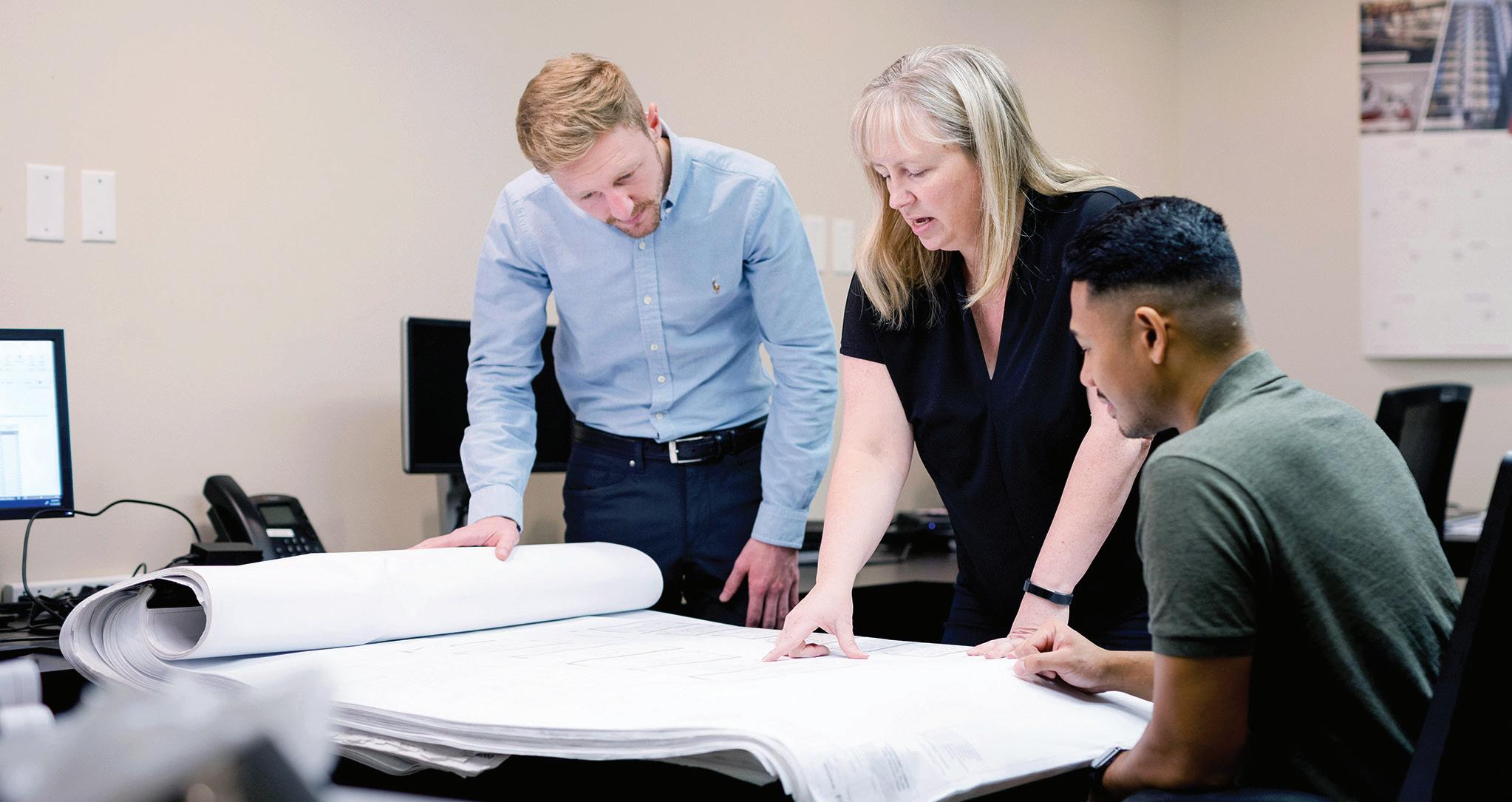

to collect and enter the information in the estimation phase and follow it through during project execution.”
After finishing the session and returning to work, says Braun, “I started using the program right away.”
By bringing junior employees
like Braun together from the company’s many locations and encouraging them not just to work but also to socialize together, Graham is reinforcing its culture and encouraging a sense of camaraderie among newer employees. “It’s great getting to know people in the company,” says Braun.
After one year with Graham, all full-time staff have the opportunity to buy shares in the company.
“I noticed after I started to invest, I was happier to do the hard work,” says Braun. “It’s a benefit for me and a benefit for my peers. The better I do, the better the company does.”
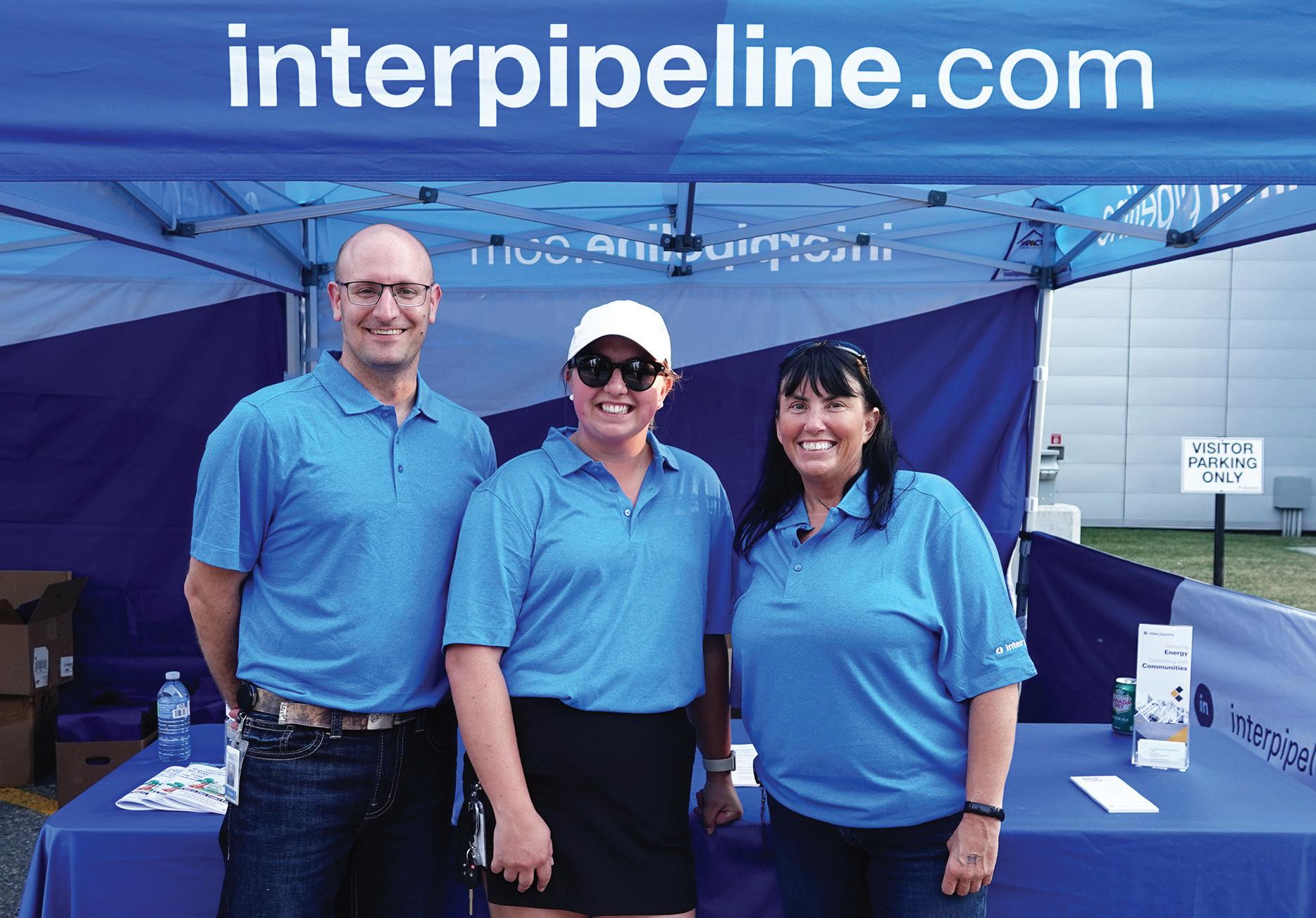
For Brooke Kenyon, the best thing about working for Inter Pipeline is making the difference in the communities where the company operates, from Taber to Fort McMurray and beyond.
“It’s so fantastic to go to the smaller communities and to see the impact we have,” says Kenyon, stakeholder engagement coordinator. “It’s a lot of fun and I have to say my favourite part is definitely the people.”
Headquartered in Calgary, Inter Pipeline is a world-scale energy company. Its 1,000-plus employees include electricians, engineers, pipeline operators, petrochemical technicians, finance and marketing professionals and analysts. It transports, processes and stores energy products across Western Canada.
Kenyon’s job takes her to Inter Pipeline’s field offices in Alberta and Saskatchewan where she engages with her fellow employees and the communities they work in. Her calendar is full of events like the annual Brooks barbecue or a community clean-up in Cochrane. Each initiative is individually tailored to the community it’s held in.
That attention to detail and
holistic approach reflects the company’s tactics when supporting its employees’ personal well-being and professional development. Supported by extensive training, education and other programs, Inter Pipeline puts the career path of its employees in their own hands.
“We want employees driving their own accountabilities,” says Breanne Oliver, vice president, people and stakeholder relations.
“That may sound scary to some but it’s really rewarding because supporting and empowering employees creates a caring culture.”
Mental health is a core company
value. Employees receive up to $10,000 annually for psychological services. Managers and team leaders are trained in mental health awareness and ways to support employees and reduce stigma. The company also provides counselling services and flexible hours to help employees achieve greater worklife balance.
Inter Pipeline has also expanded its parental leave policy to include non-birth parents and surrogacy. New fathers and adoptive parents receive a top-up benefit that brings their salaries to 100 per cent for eight weeks.
With such a large geographic
area and diverse range of employees, Inter Pipeline helps maintain a consistent company culture with constant communication. Town halls and team meetings provide personal touchpoints. Kenyon appreciates how the company’s internal online platforms keep employees plugged in on company initiatives, volunteer opportunities, social events and other information.
In-person discussion and exchange of ideas is encouraged by a family-feel, relaxed management model where employees like Kenyon can approach team leaders and executives in an atmosphere
“Everyone was just so fantastic and welcoming I knew this was the place for me.”
— Brooke Kenyon Stakeholder Engagement Coordinator
of mutual respect.
“There’s not a lot of hierarchy so it’s pretty easy to get access to the top leaders in the company and learn from their experience,” says Oliver.
“There are great opportunities to learn. Our company is large enough to have comprehensive
employee support but small enough that you get opportunities to be mentored one-on-one.”
Inter Pipeline is also committed to inclusivity. They work to ensure the company’s policy and culture makes every employee feel valued, including those who are Indigenous, members of the


LGBTQ+ community, racialized or people of varied physical or psychological abilities.
Big opportunities for growth and a small-town, friendly vibe in every office and operation site are what attracted Kenyon to Inter Pipeline and what keeps her there.
“I started as a summer student
Our
in community engagement and I have to say I was terrified because it was my first corporate job and I didn’t really know what to expect,” says Kenyon.
“That vanished within my first month here. Everyone was just so fantastic and welcoming I knew this was the place for me.”
talented team brings their passion for our industry and commitment to safety and excellence to work each and every day. Inter Pipeline is ready for the future, and the future is bright.
Can a midstream oil and gas company with more than 1,000 employees have a workplace with a “family feel” to it? Well, that’s precisely what Ryan Davis has found during his four years working at Keyera Corp.

“It feels like we’re basically one big team, all with the same goal of keeping a safe and reliable plant site,” says the mechanical engineer. “I really enjoy that.”
Davis found his new family when a friend (and now colleague) told him about Keyera, whose workforce was a fraction of the size of his previous employer – just what Davis was looking for.
Now, he works with about 70 other people at the company’s Fort Saskatchewan facility. He likes the fact that, because of Keyera’s smaller size, he is able to use more of his diverse skill set.
“I know a lot of engineers who get pigeon-holed into, ‘Oh, you’re the pump mechanical engineer, and you’re only gonna look at the pumps,’” Davis says.
“With Keyera, I look at every piece of equipment because our plant size is small enough that we don’t have a specialist at every position.”
While the Fort Saskatchewan site has a “one team” sentiment, he finds that extends to the headquarters staff in Calgary as well.
“We hear a lot from them, and it definitely still feels like they’re
part of the team and part of the family, which, to me, is what separates Keyera from other companies,” he says.
Joanna Williams, safety and operational excellence general manager, also feels that Keyera truly values its employees.
Williams would know, having worked with several different companies – as either an employee or contractor or sometimes both –
over the course of her career.
“I’ve seen quite a range of cultures and this is the closest I’ve come to feeling valued as an individual for the true diversity that I bring to the organization. I really feel heard and valued,” she says.
“This is the first time I have truly felt like a person and not a number.”
Williams has found that senior
“I’ve seen quite a range of cultures and this is the closest I’ve come to feeling valued as an individual for the true diversity that I bring to the organization.”
— Joanna Williams General Manager of Safety and Operational Excellence
management is approachable and isn’t distanced from the day-to-day operations.
“The senior executives make a real point of engaging with the front-line workers and making sure that they’re getting out and interacting and really listening,” Williams says, adding that, to her,

Keyera’s leadership embodies integrity.

“Even within the first months, I got to meet some of the VPs and the CEO,” agrees Davis. “So that was really refreshing to me.”
Williams says she finds Keyera’s leadership group inspiring.
“I look at the senior executives
and I really feel like there’s a lot of integrity,” she says. “I really feel like they do care and they want the best not only for the company, but for their people.”
A company Keyera’s size is much more nimble when it comes to making changes, Williams says, and she has already seen a number of
Every day, we're
them made in her short time there. That many of the managers are women also resonates with her.
“Our actual diversity, equity and inclusion, again, is the closest I’ve ever come to a company truly living it,” she says. “This has been a really impressive experience for me.”

And we couldn't do it without our people. Learn more about joining our team at keyera.com/careers.



Before joining Mawer Investment Management Ltd. in 2020, Anum Siddiqui first got to know the Calgary-based firm while working as a consultant. She felt drawn to the culture she observed, as it seemed both authentic and aligned with her own values.
 — Craig Senyk President and Vice Chair
— Craig Senyk President and Vice Chair
“People at Mawer spoke of having a culture of continuous improvement and about making sure to do right by their clients,” says Siddiqui, now an institutional portfolio manager at Mawer. “I was also attracted by the lack of hierarchy, a workplace where people could feel comfortable voicing their opinion regardless of position, and able to pursue interests that they’re curious about. Then when I joined the firm, it exceeded my expectations.”
From her first day of onboarding, Siddiqui says, the focus has been on culture and living by the firm’s values and behaviours. That included opportunities for personal development, such as an internal mentorship program she
participated in.
“Ten years into my career, I’m at that sweet spot where I have a lot of knowledge, but feel I still have lots to learn,” says Siddiqui. “It was really helpful to me in navigating through all my questions and concerns.”
Siddiqui says the support for employees goes well beyond the work environment. She recalls a moment early in 2022 when Mawer’s chairman, Jim Hall, joined
the weekly firm-wide call hosted by president and vice chair Craig Senyk, and announced the doubling of the firm’s mental health benefits.
“It wasn’t just that they were increasing the allowance, but that one of the most senior and successful people at the firm was talking to us about mental health, a very vulnerable topic,” says Siddiqui. “That said something to me and I think it meant a lot to
other people as well.”
Another key element of Mawer’s culture that Siddiqui appreciates is the trust given to her and her colleagues to do their work in a flexible hybrid environment.
“People know you will get your work done and it’s up to you to manage it,” says Siddiqui. “There’s true flexibility in being able to choose where and when you work best.”
Senyk says that as a values-based
“Our people are our most important asset and our culture iswhat unites us, driving
us to be the best – while having some fun along the way.”
organization, it all starts with building a culture of trust.
“Ultimately, we want employees to work where they work best –there is no mandate to be in the office on certain days. That’s one of the great learnings to have come out of COVID. It’s much more fluid now than in the past,”
says Senyk.
“People come into the office to see other colleagues or to meet clients,” he says. “When we do bring everyone together, there’s a specific purpose behind it, such as an employee committee social gathering or a firm-wide culture event.”
Senyk describes culture events as opportunities to bring the entire organization together to reconnect and reinforce the firm’s core values and behaviours. Most recently, the firm held an event where all staff gathered to share personal stories about Mawer’s history and culture in a rapid-fire, “hackathon” style.

Senyk called the event a “fun, fast, and fascinating way for the entire firm to reconnect and build trust throughout the organization.”
“Our people are our most important asset,” says Senyk. “And our culture is what unites us, driving us to be the best – while having some fun along the way.”
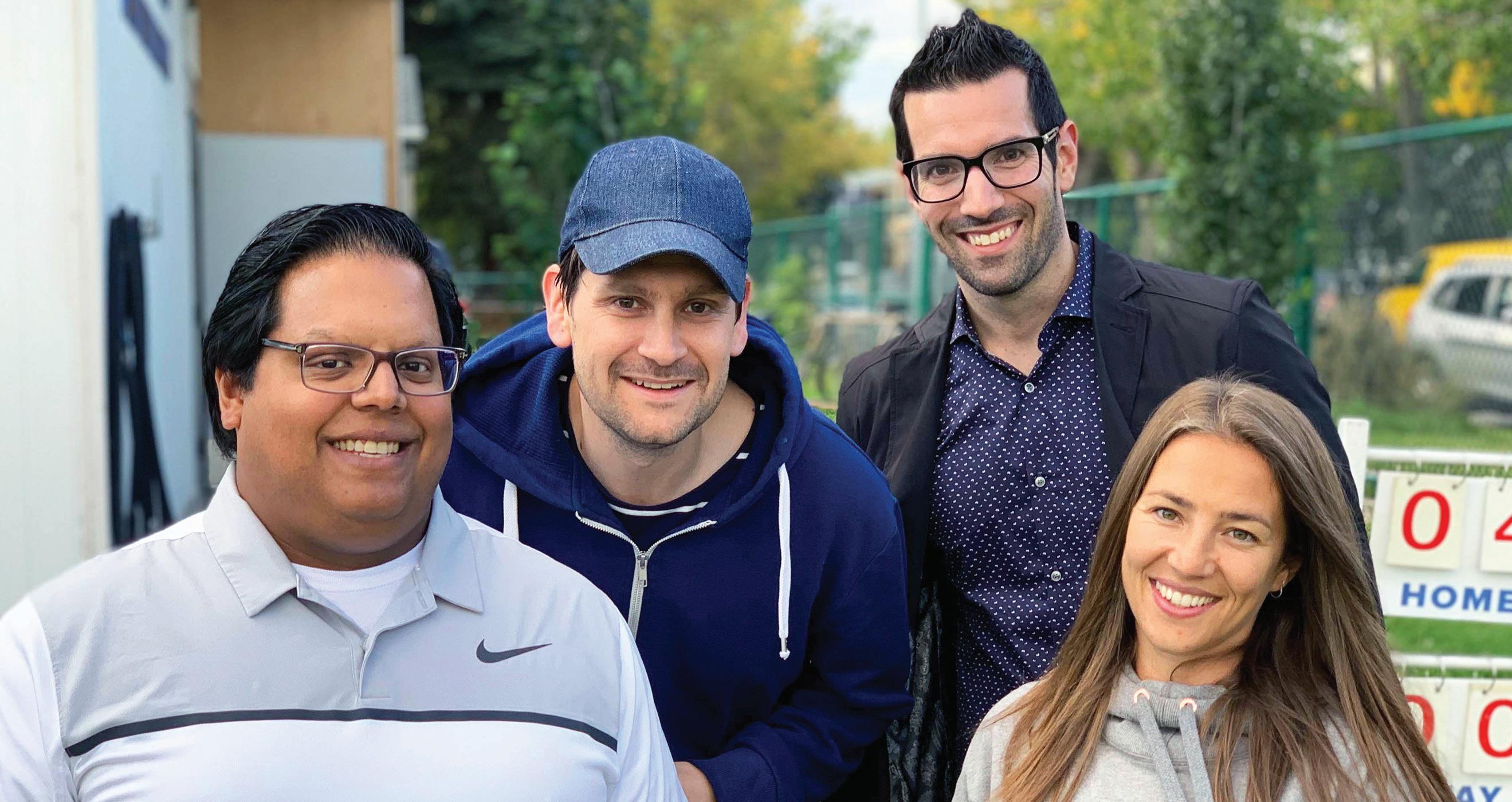
Laurel Tokuda began her career in the skilled trades as an electrical apprentice at the Northern Alberta Institute of Technology (NAIT) and that was the start of a rewarding journey.
Tokuda became a red seal electrician, worked in the trade for several years, then returned to NAIT in 2013 as an instructor. This fall, after holding several leadership positions, she became the first female head of the electrical installations department.
“There are a lot of opportunities at NAIT to grow and pursue things you’re interested in,” says Tokuda. “Our culture is very supportive and respectful. As an instructor and then associate chair and now a department head in the school of skilled trades, I’ve had support all along the way.”
Her career trajectory is not unusual. “I don’t think people realize the enormous opportunities for advancement at NAIT,” says Melanie Rogers, vice president, external relations. “We have deans who started out as instructors. They served as chairs and advanced to associate deans and then deans. It’s impressive.”
As a leader in the institution, Rogers sees it as her responsibility to ensure that employees have opportunities to grow and develop. “Leaders take an interest in the upcoming stars on their teams,” she says. “I’ve got folks on my team who I just know are destined for great things. My job is to get barriers out of the way.”
Apart from that, the institution is deeply committed to equity, diversity and inclusion (EDI). “We’re building a community where everyone can feel welcome and included,” says Rogers. “But it’s a journey, not a destination. We continually aspire to improve equity in our working and teaching spaces. An inclusive
community is key to attracting and retaining top talent.”
NAIT’s office of equity, diversity and inclusion offers subject matter expertise to ensure that EDI shapes policy and projects and is applied in teaching spaces. In addition, “there’s been a lot of EDI workshops over the years,” says Tokuda. “I’ve participated in

“We’re building a community where everyone can feel welcome and included.”
— Melanie Rogers Vice President, External Relations
1,744 6 100% 44%
full-time staff in Canada
weeks, maternity leave top-up pay job-related tuition subsidies of board of directors are women
workshops on intercultural teaching, intercultural students and safe spaces.”
She adds that as a person of colour and a woman in the trades, she has been involved in a number of initiatives to promote diversity, including Jill of All Trades events for high-school girls. “Often,
there’s not a lot of opportunities for girls to consider the trades as a career,” says Tokuda. “We bring them to NAIT and give them an opportunity to explore three different trades.”
The support she received when she was considering the trades made a big impact. “I met two
women instructors at NAIT who were my mentors through my apprenticeship,” she says. “They helped me navigate the waters of being a woman in the trades when there weren’t many of us. A lot of supportive men helped me along the way as well.”
A career at NAIT also affords
the opportunity to make a difference. “Everyone wants a broader purpose,” Rogers says. “NAIT has been making a meaningful contribution to the economy for 60 years through the talent that graduates from here. The people who work here really care.”
For 12 years NAIT has been named one of Alberta’s Top Employers.

NAIT staff are truly what makes NAIT an outstanding place to work. The culture reflects our shared values of respect, collaboration, celebration, creativity and accountability. Dedicated and passionate employees bring these values to life every day.
Join the team: nait.ca/careers

As a verification engineer for NovAtel Inc., part of Hexagon, Jamie Horrelt couldn’t be happier with where her career path – which had its share of random turns – brought her. Horrelt, a Prince Edward Islander with a BA in finance and English literature had decided, after one summer in a bank, that “finance was not for me,” and was in Banff working as a server when she became fascinated with geomatics engineering.
She enrolled at the University of Calgary, won a geomatics competition sponsored by Calgarybased NovAtel, and ended up at a company that provided not only fascinating work but also intensive career support.
“The work is really, really cool,” says Horrelt. “Geomatics is essentially the engineering of anything in space in relation to other things, and NovAtel makes global navigation satellite system [GNSS] products, which I verify are working,” she continues.
“But one of my favourite things about NovAtel is the career possibilities it offers,” Horrelt says. “I started straight from school three years ago, and I’ve had
so many opportunities to work on different projects, to change positions, get promotions and get training.”
Horrelt’s experience reflects a core aspect of NovAtel’s culture, says Tannis Schwarz, vice president, human resources. As a key but relatively small part of a much larger company – the Swedish technology giant Hexagon has 23,000 employees in over 50 countries – NovAtel offers “the best of both worlds,” according to Schwarz. “We have the strength
and resources of a global organization, and the ability to operate with the flexibility and feel of a much smaller company.”
Mentorship is a long-standing commitment of senior management, Schwarz says. “They really get the importance of that, and are willing to invest a lot of their time mentoring. Sometimes they’ll take on more than one mentee. Anyone can apply, and my team works with applicants to understand what their goals are, and who – usually someone they would not normally
interact with – would be a good mentor to support their goals.”
The feedback has been strongly positive over the years. “We hear a lot about how it’s really helped people grow and develop their careers,” she says. “And it’s led to a mentoring culture, as lots of people who have participated are starting to mentor others in all levels of the organization.”
A mentorship culture has provided a solid bulwark in a time of rapidly evolving workplaces and churning workforces. “We have

“I don’t think that I’ll ever be stagnant in my career here, and that's exciting.”
— Jamie Horrelt Verification Engineer
employees with very specialized skill sets that are in demand and competitors who are approaching them,” says Schwarz.
“But, while we are still doing better than most companies in turnover, we recognize the challenge and are putting more emphasis on the retention side of


















things,” she says. “That’s especially so with the people who joined us during the pandemic who haven’t had the absorption into our company culture. Management gets the importance of our people and of furthering their careers, and that creates an environment people want to be part of.”
Speaking last November about her forthcoming three-week posting in Hyderabad, India, Horrelt was excited about the mutual benefits she expected. “We have a whole team there, and I’ll be helping them with the setup, because there are different GNSS issues in big cities and different satellites
there. I’m really looking forward to learning from the culture and from our team there, and hopefully teaching them some things too.”
NovAtel offers so much support and opportunity, says Horrelt, “I don’t think that I’ll ever be stagnant in my career here, and that’s exciting.”







We were an early pioneer in the development of positioning and autonomy and we continue to be a trailblazer in advanced technology the world relies on. Join our team.




positionyourcareer.com






With a title like team lead, technology architecture, you might expect to find PCL Construction employee Terence Yung at a Silicon Valley conglomerate. Instead, he’s spent the last 10 years in Alberta helping his industry evolve.

“The construction business has typically been viewed as an older industry where we’re just building buildings and not as an advanced industry that leverages technologies,” says Yung.
But advanced is exactly what PCL is, he points out – a construction industry giant supported by a burgeoning business technology workforce. Yung and his team are based in Edmonton, North American headquarters for the 116-year-old company since 1932, and home to most of its technology, accounting, human resources, marketing and other teams.
“I lead a combined team of technology analysts and solution architects who are responsible for overseeing the back-end IT infrastructure services, and for designing new technology solutions,” he says.
In the past decade, he notes,
PCL has migrated 95 per cent of its formerly on-premise IT infrastructure into the cloud as part of a bold decision to stand out as a construction company with a high-tech edge. “The migration allowed us to align our IT directions with tech giants like Microsoft, and build scalable solutions for our business,” Yung says. Those solutions include software that collects data through sensors around job sites. They bridge the gap between technology and construction, and they give employees on site and in offices
the information needed to work more efficiently and deliver results to clients.
“Now we know in real time what is happening on site, which frees people to do more meaningful work than just collecting information,” says Yung.
The construction company’s pioneering embrace of cloud technologies has created a host of tech career opportunities at PCL, says Harmony Carter, vice president of people and culture. “It’s the buildings that bring us attention,” Carter says, “which is
understandable since we’ve built many of the arenas and stadiums in this country, several large-scale civil infrastructure and industrial projects and the tallest high-rise in Western Canada in Edmonton.
What people don’t realize is we are actually one of the biggest IT employers you’ll find in Alberta.”
This means PCL is in a position, according to Carter, to shape the future direction of large-scale construction. “We have the ideas and the problems to solve,” she says, “so we’ve taken an innovative and forward-thinking approach,
“What people don’t realize is we are actually one of the biggest IT employers you’ll find in Alberta.”
— Harmony Carter Vice President, People and Culture
2,702
14 220 $7M
where we don’t have to find someone in the market to provide solutions.”
It means that new tech graduates looking for work should look at PCL, which is only going to expand further in that direction, says Carter. “Everyone thinks of PCL and construction together,

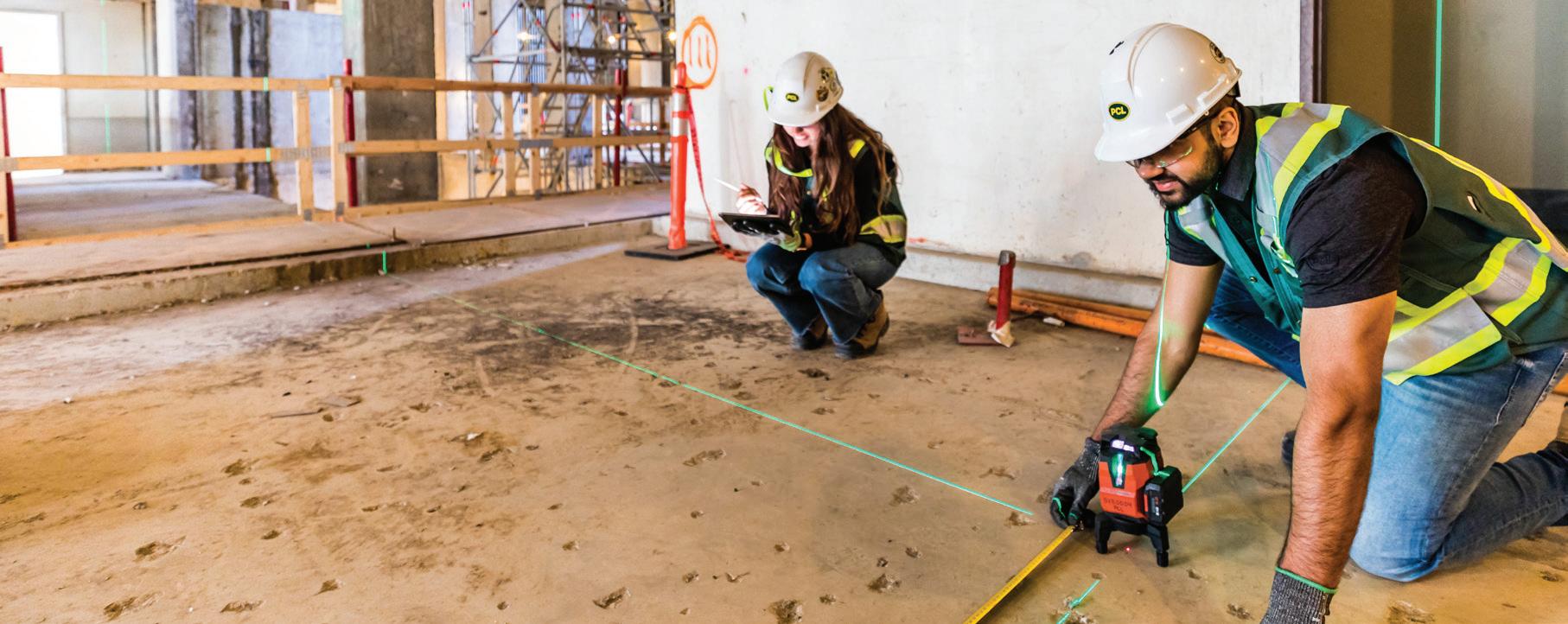
but they’re not thinking of us as tech right away. We want to change that – we’re both.”
Innovative thinking is just one way PCL is attracting top talent across the company. Entirely employee-owned for almost half a century, PCL invests deeply in its employee-owners, with a
strong mobility program through which employees can relocate to one of the locations across North America or Australia. They can take advantage of opportunities to develop their careers quickly, and numerous open-to-all leadership courses.
The community-minded ethos
extends even to its tech investment.
“We think we can enhance our entire industry,” Carter says, “by choosing to build technology with the idea we can pass it to other construction companies, so that they can also improve how construction is built in this country.”
Coming out of the University of British Columbia with a finance degree, Jeremy Johnson-Silvers could have followed some of his fellow graduates into traditional careers with accounting firms or big banks. Instead, he returned to his Edmonton hometown and joined PRIMED Medical Products.
“PRIMED offered me an opportunity to dive right in to project work and actually have an impact on the business,” says Johnson-Silvers, manager of corporate development. “I could see that what I was working on was making a difference to the bottom line.”
Founded in 1995, PRIMED initially imported and distributed Chinese-manufactured personal protective equipment (PPE) such as face masks, medical gowns and examination gloves, among other products.
However, in the early 2000s the company began designing and manufacturing its own PPE.
PRIMED now has five manufacturing facilities – three in China, one in Laos and another in Cambridge, Ont. – and is the
largest supplier of these products to the Canadian health-care market.
President and CEO David Welsh says PRIMED has grown quickly, and achieved a dominant position in the Canadian market, largely on the strength of talent that the company has recruited and trained.
“The number of individuals who work here and have grown up within the company is pretty
substantial,” says Welsh. “Some of our most senior people have been with the company 20 years-plus and it was their first job with a bachelor of commerce or a science degree.”
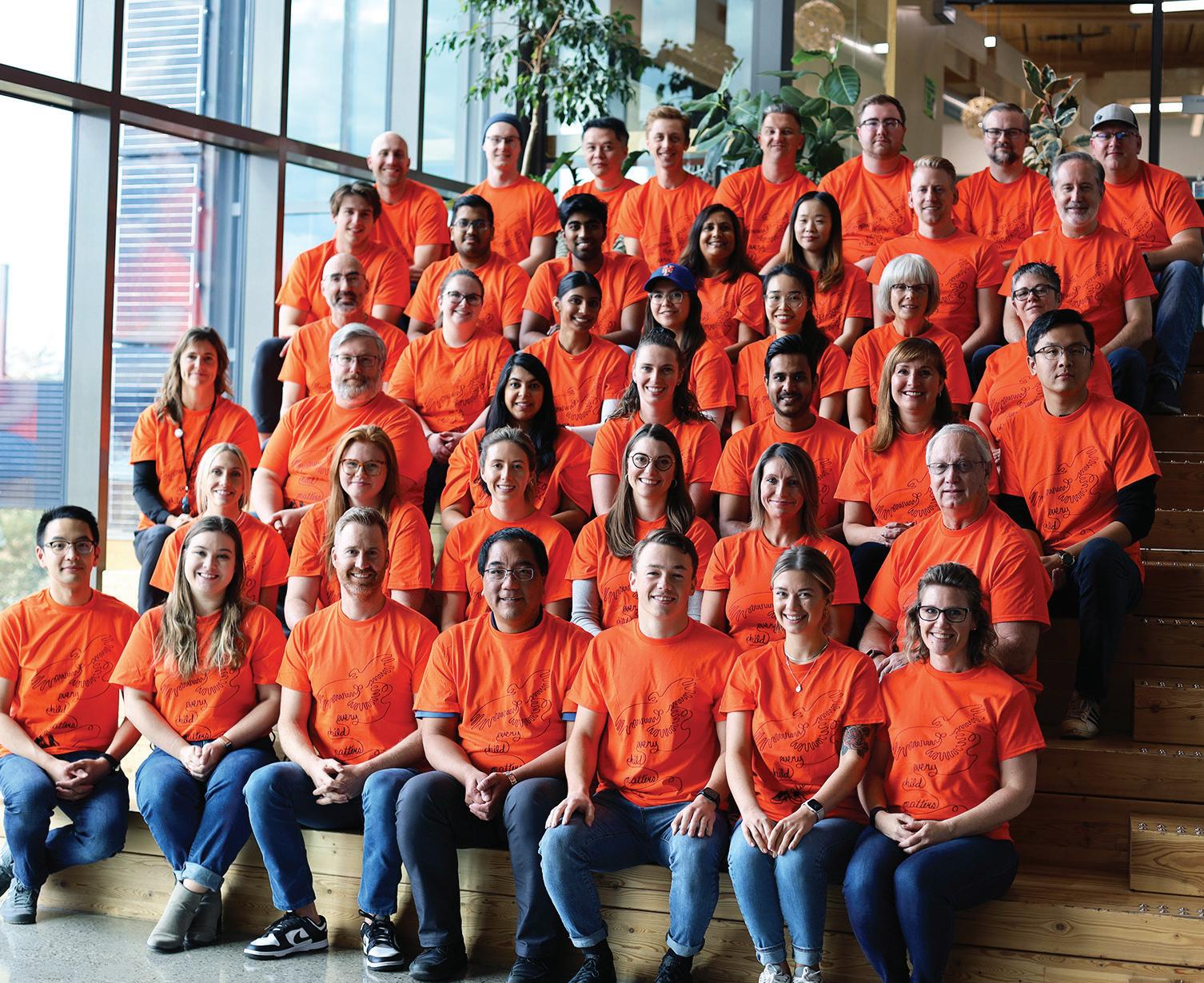
That is no coincidence. PRIMED has had an internship program for over 15 years and routinely hires up to a dozen interns a year.
“It’s been a huge benefit to us,” says Welsh. “The young people bring energy. It’s part of our
culture and our responsibility to the community to give these opportunities to young people from the Edmonton area.”
Johnson-Silvers spent two summers as an intern, first as a sales associate and then as an assistant to Welsh. In the latter role, he accompanied his boss on a site selection tour for a new manufacturing plant that took them to the Dominican Republic, Mexico and Southeast Asia.
PRIMED employees wearing the official 2022 Orange Shirt Day design on National Truth and Reconciliation Day.
“PRIMED offered me an opportunity to dive right in to project work and actually have an impact on the business.”
— Jeremy Johnson-Silvers Manager of Corporate Development
After he graduated, JohnsonSilvers was handed responsibility to manage the construction of the new Ontario manufacturing facility and handled similar duties while the Laos plant was being built.
“The company pushes the junior staff to take these stretch assignments and really learn, but there’s

always a safety net,” says JohnsonSilvers. “We always have someone who knows the business and is able to support you.”
PRIMED may be a smaller company, but as a fast-growing enterprise, it always has new positions and opportunities opening up.

“The organizational charts that we build for the future are already set,” says Welsh. “We know what we’re expecting for the next three years, which creates clear career pathways.”
To date, PRIMED’s success has rested largely on recruiting young talent and allowing them to
grow with the company, and that approach will likely continue.
“Our business is specific enough that the value of developing people internally cannot be denied,” says Welsh. “It’s very hard to go outside and find the right talent and experience because we’re a unique business.”
During her time working in the financial world, Rishma Manji would often spend her spare time volunteering to help foundations raise money. But she never thought about making it her career until she learned about the work being done by the Royal Alexandra Hospital Foundation.

“I think my passion has always been in non-profit,” Manji says. “And then the combination of non-profit and health care and the direct impact it has on society really was what drew me.”
Manji first learned about the work of the Edmonton-based foundation after she found herself chatting with its president and chief executive officer, Sharlene Rutherford, about another matter.
“We weren’t talking about work, we were just talking about what she does,” Manji says. “So then I looked a little further into what the foundation was all about, and I was really intrigued. And so I kept a watch on the foundation and when there was a position available, I applied. One thing led to another and here I am.”
Manji, who moved from Calgary to Edmonton for her new job as a development officer, says she was excited to see how the work she and the foundation were doing impacted her new community.
“Philanthropy has always been something that has intrigued me, but I’ve only done work for foundations that really impact the Third World,” says Manji, who marked her one-year anniversary with “the Alex” in November.
“And so it was kind of cool to see Canadian dollars working for Canadians.”
Rutherford, who has been with
the foundation since 2005 and is its longest-serving employee, remembers fondly the first time she was able to show off a new piece of technology to the donor whose gift helped pay for it.
“I saw the look on that donor's face and was able to say to that donor, ‘Here’s what you’ve done. Look what you’ve enabled.’ And it was such a high to be able to do
that,” she recalls. “I felt like I was walking on air because of what we accomplished together.”
In her role as president and CEO, Rutherford aims to see the foundation’s values – excellence, innovation, integrity, respect, strong relationships and stewardship – underline all of its actions and interactions. Everyone has a voice, she says, from the newest
“We believe in having joy in the workplace.”
— Sharlene Rutherford President and CEO
employee up to the board of directors.
“Our success resides in the success of donor engagement, and the impact donors have on the hospital. That’s where our successes are, and if we always keep that in mind, then it makes the workplace far more enjoyable.


And we believe in having joy in the workplace.”
That workplace sat empty but for Rutherford during the height of the pandemic. She, for one, is happy to have the tight-knit staff back.
“There’s so much energy here, you just feel a little bit more
engaged and alive. And it’s so nice to hear laughter down the hallway,” she says.
“There’s even been a couple of days where I’ve had to close my door – when I’m either in a meeting or working on something – because I’m not used to the sounds down the hallway of
laughter and chatter, but I love it. It’s like, ‘Wow, this place is alive!’”
Manji, meanwhile, says she has settled seamlessly into her new job and the Edmonton community except for one point.
“I think the most difficult thing for me,” she laughs, “was to put on an Oilers jersey.”
Calgary-based Rümi is a company with a clearly defined purpose – to make people happy by making it easier for everyone to love the places they live or work. What is true for Rümi’s customers is also true for Rümi’s employees.
“Everything we do is driven by our core values of integrity, caring, collaboration and agility,” says Sarah Francis, vice-president people and customer engagement. “It defines how we treat our customers and how we treat each other.”
Rümi (pronounced “roomie”) is a subsidiary of ATCO Ltd., a major corporate presence in Alberta for more than 75 years. Launched in 2021, Rümi offers customers a wide range of services and products aimed at supporting happy, stress-free homes.
The company’s customer care team, known as customer happiness advisors, help connect clients with carefully curated firms that deliver everything from yard care to home inspections to electrical installations and repairs.
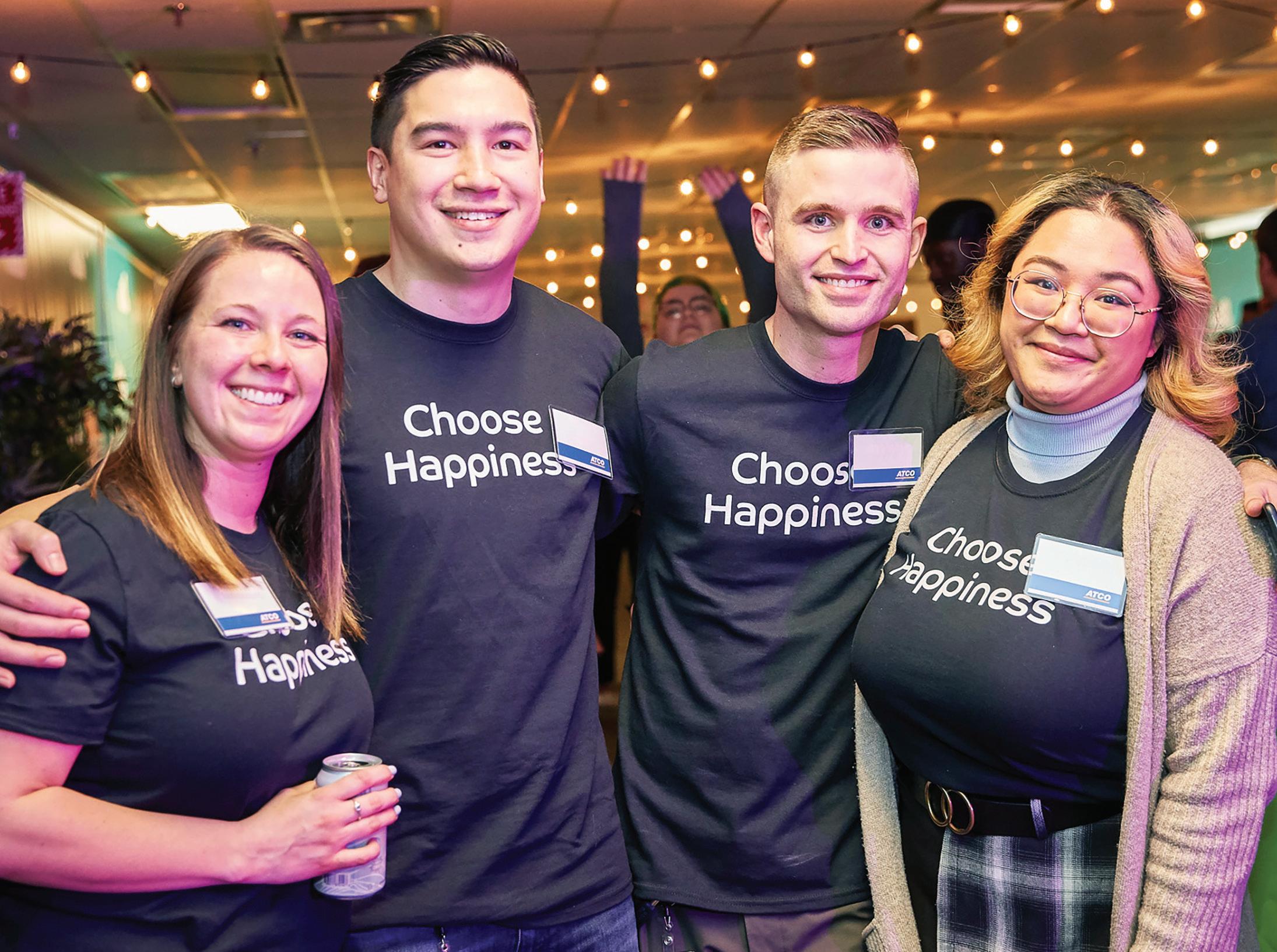
Rümi also sells energy plans through ATCOenergy and now runs the venerable Blue Flame Kitchen, founded in 1929. Today, Blue Flame Kitchen includes a
café, a private events space and cooking classes at Calgary’s ATCO Park site.
The core value of caring is particularly important for Erin Rainey, customer experience and operations advisor with Blue Flame Kitchen.
“It’s a big one,” says Rainey. “This is an organization that welcomes you and makes you feel valued. And I know it’s something that’s attracted many employees here.”
Rainey has also seen the core value of agility in action, especially
during the pandemic.
“We had to shift quickly to offering curbside takeout meals and virtual cooking classes,” she says. “We’ve been open to the public again since the spring of 2021, but we’re continuing to offer our holiday meals on a takeout basis because they proved so popular.”
Rainey adds that employees, who call themselves Rümineers, enjoy a workplace culture that is upbeat, fun and down-to-earth.
“My team is essentially my work family. No matter how stressful
or busy our day is, we can always share a good laugh or two and there’s always someone you can lean on and talk to.”
Rainey says the organization encourages a healthy balance between work and personal life and that’s reflected in some of the “out-of-office” emails her colleagues post.
“My favorite recent one said, ‘I’m out of office and won’t be able to answer emails as I’ll be out dirt biking and off grid.’”
Francis says Rümi’s central purpose of helping people live
“This is an organization that welcomes you and makes you feel valued.”
— Erin Rainey Customer Experience and Operations Advisor
happier lives is talked about a lot during the company’s recruitment efforts.

“If that speaks to you then you are certainly our kind of person,” she says. “We also look for people who will add to our culture and bring in a diversity of experiences.”
Once a person is onboard,
Francis says, Rümi puts a laser focus on leadership development, helping prepare team members for a wide range of opportunities.
“We’ve already had a number of great success stories in terms of internal promotions. We are also fortunate to be part of a much larger organization in ATCO Ltd.,
which provides opportunities around the world.”
Giving back to the community is another key priority.
Employee-driven partnerships have been forged with three key charitable organizations that align with Rümi’s core purpose. They are Habitat for Humanity, WINS
(Women in Need Society) and HomeSpace Society, a leading affordable housing provider.
“In addition to fundraising, our Rümineers can take paid time from work to volunteer for these organizations,” says Francis. “It’s another exciting way to connect and see our culture in action.”
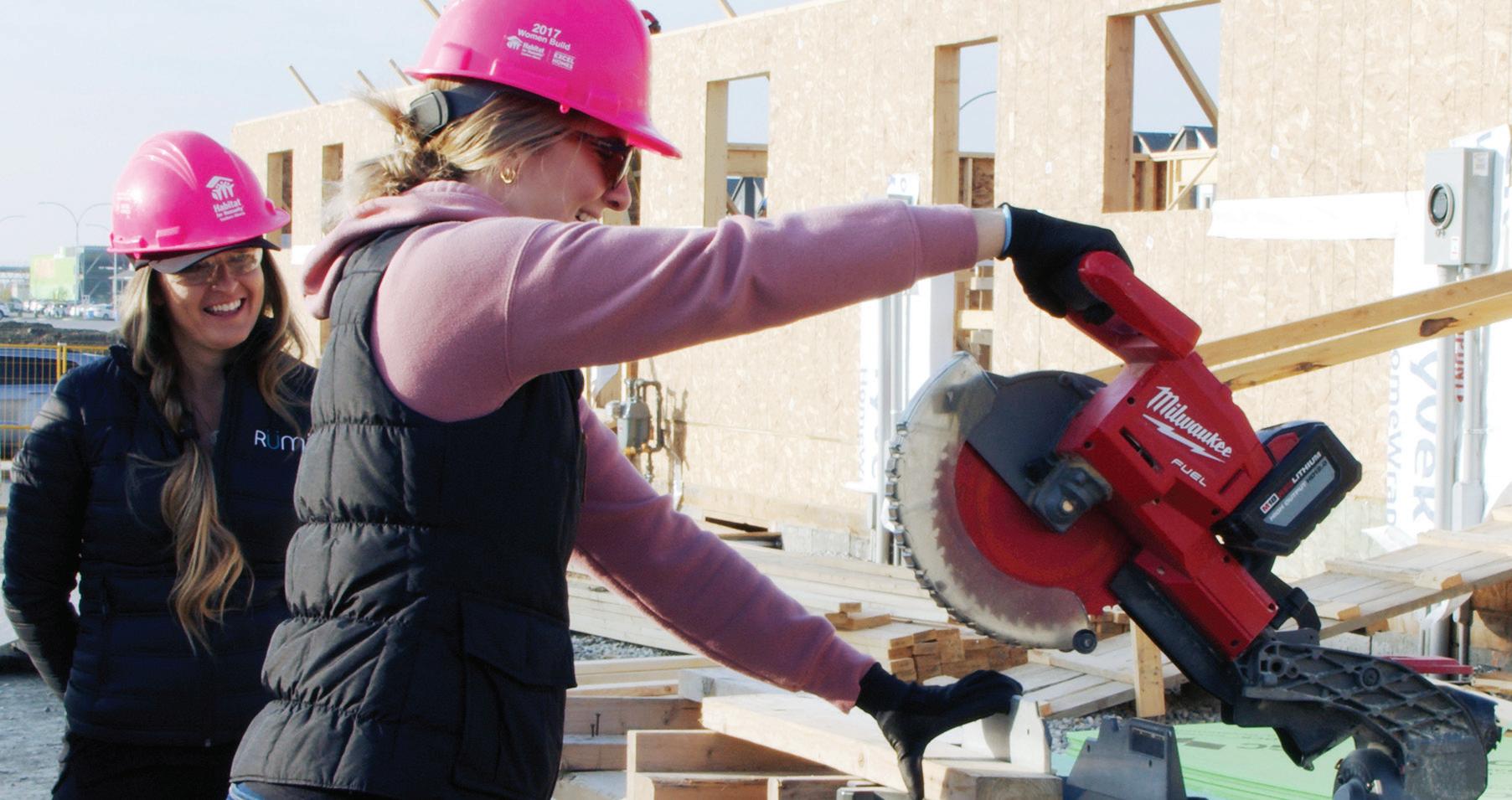
For Felicia Adeniyi, diversity and inclusion aren’t just goals, they’re her job. As an officer in the Equity, Diversity, and Inclusion department at the Southern Alberta Institute of Technology (SAIT), she says that they were the first thing on her mind when she applied to be an administrative assistant at the Calgary post-secondary institution.
“I needed to see what they were doing right,” she says, “to see if their values aligned with my values before applying to the organization. I wanted to be in an organization where I’d have a great experience, and where an opendoor policy is being practised.”
With over a century of history and a venerable campus overlooking downtown Calgary – as well as nearly a half dozen satellite campuses and facilities all over the city – SAIT has chosen to embrace change rather than tradition. Offering courses and degrees in specialties ranging from hospitality, culinary arts and health to public safety, communications and transportation, it has to train
students for both current and emerging industries inside and outside the province.
For Heather Magotiaux, vice president of external relations, this begins with a set of “first” principles that are easy to remember –fairness, integrity, respect, safety and transparency. They apply to both students and employees, many of whom help maintain relationships between the school and the industries their students
are training to join.
“We’re looking for people who will embody those values and who will live by those principles,” she says. “Also, people who are curious, who are creative, who are critical thinkers. And it’s really key that you’ve got to be collaborative and you’ve got to be focused on building relationships and building connections.
“SAIT is very integrated with the industry, and so the ability to build

those relationships and keep those connections is part of what keeps the programming that we offer to students so relevant to the world of work.”
Professional development is key to attracting and retaining staff and faculty, with subsidies offered on tuition for credit courses, as well as programs like Women in Trades and Technology, which aims to increase representation in specialties where women have
“I wanted to be in an organization where I’d have a great experience, and where an opendoor policy is being practised.”
— Felicia Adeniyi Administrator, Equity, Diversity and Inclusion Department
1,593
21,168 41 52%
job applications received last year years, longestserving employee of managers are women
been under-represented. Speakers, conferences and mentorships help create the sorts of networks Magotiaux says are key to fostering diversity.
“A lot of people have been focused on trying to increase the diversity within the organization, whether it’s from the student body
or employees,” says Magotiaux about SAIT’s ongoing equity, diversity and inclusion efforts.
“But in the last couple of years, since we launched our diversity and inclusion plan, we have also focused on the leadership of the organization, because that’s where the hiring takes place. That’s
where we have the ability to really make it a core principle of the organization.”
Moving into the new Equity, Diversity and Inclusion department as an officer helped Adeniyi realize the goals she had when she joined SAIT. “As an employee, you have a sense of
belonging, you know you’re valued, and you know when you give your ideas to your manager or your leader, it’s accepted,” she says.
“SAIT has given me the opportunity to learn, grow and excel. It’s also a community that helps you create value while you’re being valued.”
At SAIT, we are developing the next generation of leaders advocates, and explorers.
We are bold, inventive and strive to make a difference in our students' lives — as well as those of our employees.
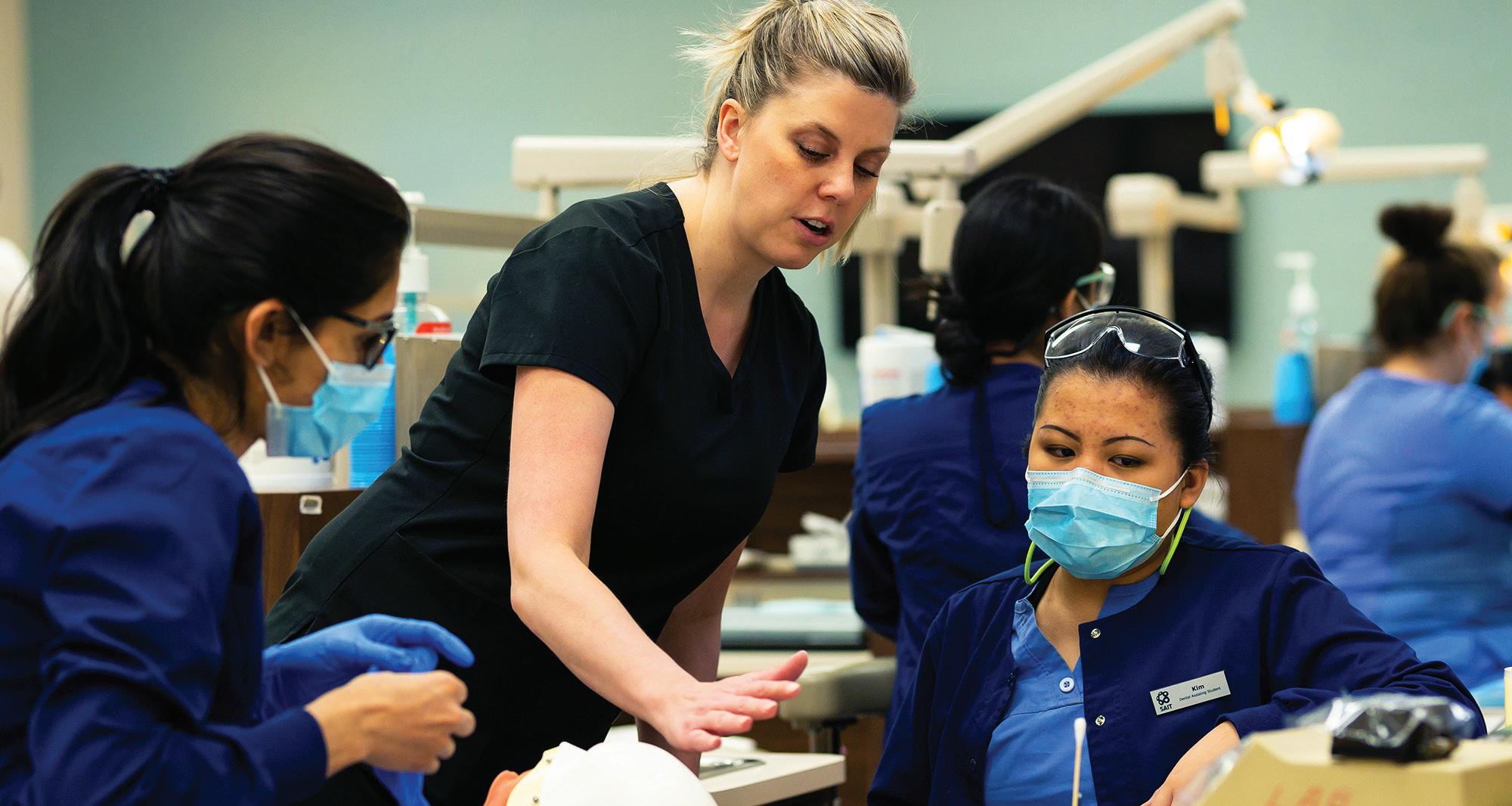

Whether you are an employee or a contractor, or you drive a car, fly in a jet-plane or benefit from charitable groups in Alberta, the people at Shell Canada Ltd. are helping to power your community.
“We power lives through our products, through our workforce and through our activities,” says Maria Paquet, human resources manager, Canada. “Powering lives is also one of our four pillars, along with striving for net-zero emissions, respecting nature and generating shareholder value.”
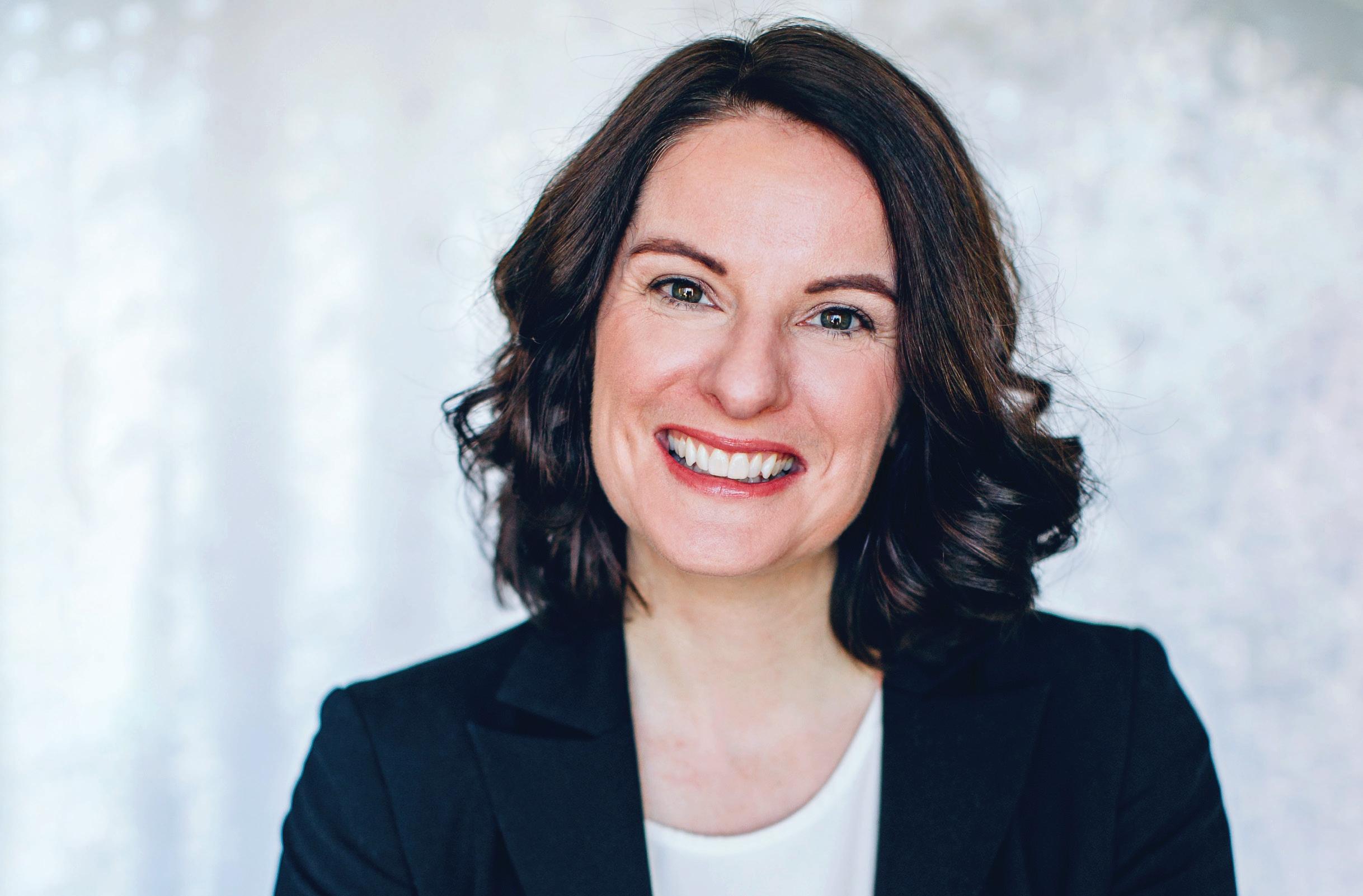
Shell’s largest plant is the Scotford Chemicals & Energy Park just outside Fort Saskatchewan, near Edmonton. It refines oil to produce diesel, jet fuel, gasoline and some chemicals for local markets, says Scott Lang, maintenance manager, Edmonton.
Scotford employs 1,200 workers
while several hundred more work at Shell’s headquarters in Calgary, as well as elsewhere across Canada.
“The number one way we power lives is our contribution to our community through the number of employees,” Lang says. “During our significant routine maintenance shutdowns, we’ll employ up to 3,000 contract people. That’s money that goes straight back to the local communities.”
Tradespeople from across the province travel to the Scotford plant for the major shutdowns. That is when everything needing repairs or new construction happens, he says.
“Alberta holds a significant
portion of the skilled tradespeople in Canada and it’s important we keep those vital skills in the province so everyone can contribute to their communities,” Lang explains.
Paquet adds: “We strive to hire and develop local talent and support the regions we operate in, mainly Calgary and around Edmonton, but also in the smaller surrounding communities.”
Another way Shell powers communities is through supporting Indigenous Peoples, she says.
“In 2022, for our chemicals and products business alone, we have spent about $4.6 million with Indigenous communities in the area. Partnering with First Nations is an example of how we’re
powering lives in different ways and in the broader community,” she explains.
Scotford also supports local communities through a longstanding partnership Shell has with the United Way. The annual drive usually raises more than $450,000, with events such as online auctions and chili cook-offs, Lang says.
He notes that employees contribute to other local charities as well.
“For every shift that we work safely during our major shutdowns, without injuries to either employees or contractors, we make a donation to a local charity,” he says. “In the last three years we’ve donated $54,000 to the Rainbow
“Alberta holds a significant portion of the skilled tradespeople in Canada and it’s important we keep those vital skills in the province so everyone can contribute to their communities.”
— Scott Lang Maintenance Manager, Edmonton
Society of Alberta. They grant wishes, like trips to Disney World, to terminally ill children and their families.”
Paquet adds that Shell also has a giving program through which employees can donate to a non-profit organization and the company matches the donations,
or contributes $20 per volunteer hour, up to $1,500 a year for each employee. Already, $1.4 million has been distributed to 652 notfor-profit organizations across Canada.
“My HR team at head office had an assembly line and we put together personal care hygiene kits
for a local drop-in centre,” says Paquet. “I had a sense of pride giving back to this amazing city. It’s wonderful to be part of an organization that supports us in doing that.”
Lang notes that others in the oil business worry there’s a finite life to their careers and companies.
“Shell’s chosen a different path –how we’re going to evolve to meet the demands of society with sustainable, low-carbon energy solutions for all Albertans,” he says.

“There’s a real recognition as a company that we’re powering lives and communities differently. And that thrills me.”

To understand what makes UFA Co-operative tick, you don’t have to look too far.
“It’s right there in the name,” says president and CEO Scott Bolton. “We’re a co-operative and that means we work together on behalf of our members, who are also our owners and our customers. That collaborative approach is what attracts us to work at UFA.”
Founded in 1909, UFA has grown into the fourth-largest co-operative in Canada, serving over 120,000 member-owners. Today, UFA employees help supply petroleum, crop inputs, livestock supplies, building products and services through 34 UFA Farm & Ranch Supply stores and six UFA Fertilizer plants across Alberta, and 111 Cardlocks and UFA Petroleum agencies in Alberta, British Columbia and Saskatchewan.
Bolton adds that UFA is the very definition of a grassroots organization.
“Whether your farm is 500 acres or 5,000 acres, you are one member and get one vote. As a practical matter, that means no one controls the co-op and everyone has a say. Our grassroots membership keeps all of us grounded.”
The co-operative model also explains why UFA places such a
high priority on giving back to the community. Initiatives include everything from raising money for rural and small-town food banks to investing in agricultural education and supporting the venerable 4-H Alberta youth development program, which was founded in 1917.
“Community investment is tied to the hip of what it means to be part of UFA,” says Bolton. “It’s very gratifying to know we can contribute to the betterment of our communities.”
Tate Sutter grew up steeped in
UFA tradition. Raised on a farm near Alliance, his mother worked as a UFA customer account manager, the same position Sutter now holds, working out of UFA’s Stettler Farm & Ranch Supply store.
Sutter worked as a summer student for UFA in 2021 before completing his crop technology degree at Vermilion’s Lakeland College. He joined the organization full-time in the fall of 2022.

“I already knew how tight-knit UFA was and how well they treated their employees,” says Sutter. “I
was also aware of how much they supported rural communities.”
Sutter says his favourite part of the job is providing his customers, many of them long-time neighbours, with advice and products that help them succeed.
“I get to work with all these people who have known me since I was a kid,” he says. “To see them have a successful crop year and to be excited for next year’s yield gives me a lot of satisfaction.”
Sutter says he also welcomes all the opportunities for career growth within UFA, something
“Our grassroots membership keeps all of us grounded.”
— Scott Bolton President & CEO
1,034 44 400 100%
Bolton says is an essential part of UFA’s employee value proposition.
“We pay competitively and reward performance, but I think the secret sauce is the way we allow you to grow your career while also achieving personal life goals,” says Bolton.
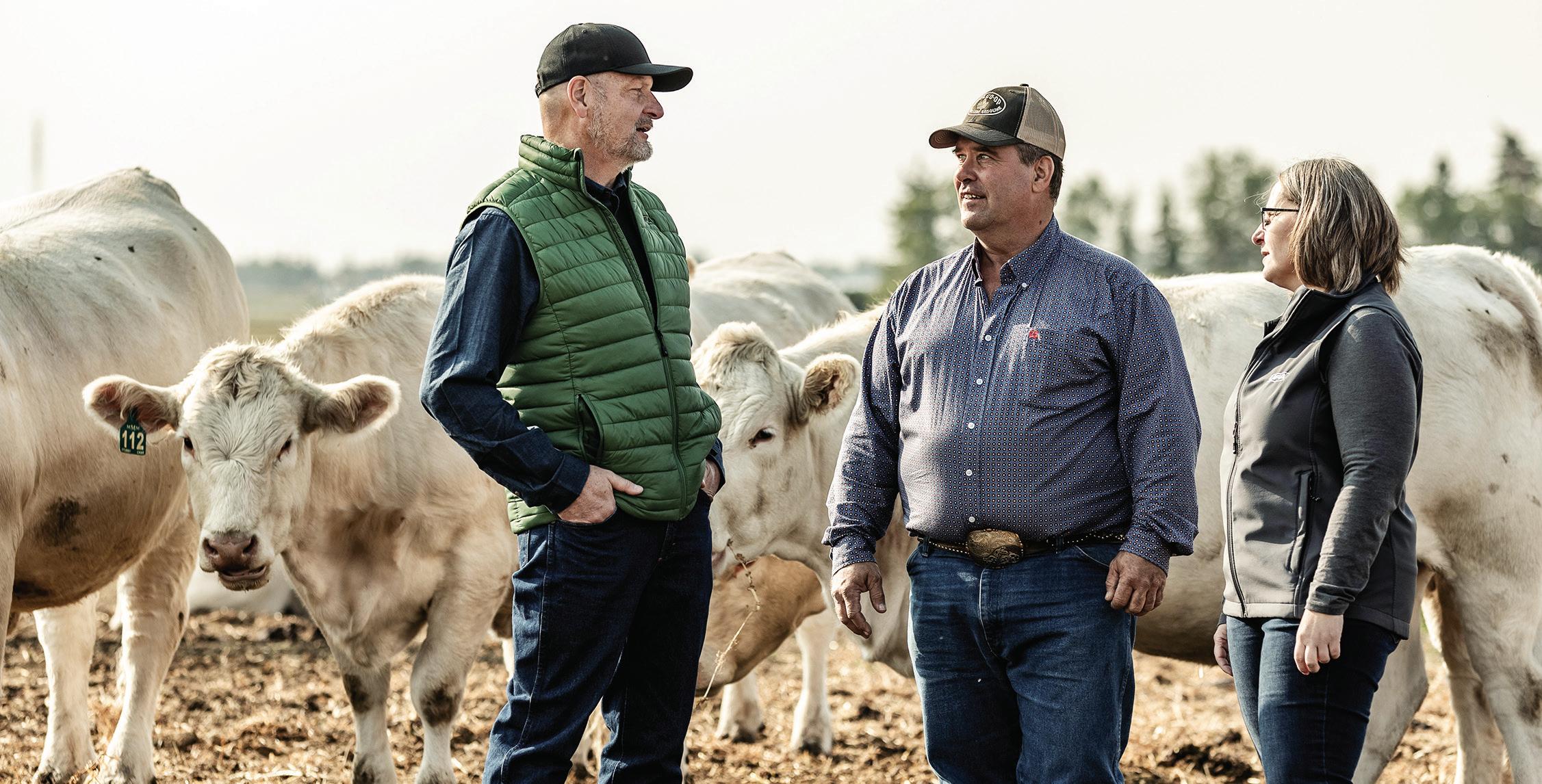
As a large, multi-faceted
organization, he adds, UFA offers diverse career opportunities and puts a strong focus on coaching, mentoring and training to help employees realize those opportunities.

But it’s not all about work.
“UFA is a hard-working culture, but balance is important,” says
Bolton. “We want you to succeed in your personal life as well.”
Bolton says the pandemic presented UFA with significant challenges, but he feels the organization emerged stronger and more resilient than ever.
For one, the organization has found new ways to connect its
employees and membership through technology.
That’s a positive, says Bolton, but nothing will replace the old ways.
“We’ll continue to get in the F150 and drive into the country to meet our members face to face. That’s really what we’re all about.”
Call “care” centres, a caring company culture and charity commitments are three ways Western Financial Group contributes to the 43 rural communities it serves with branches across Alberta.
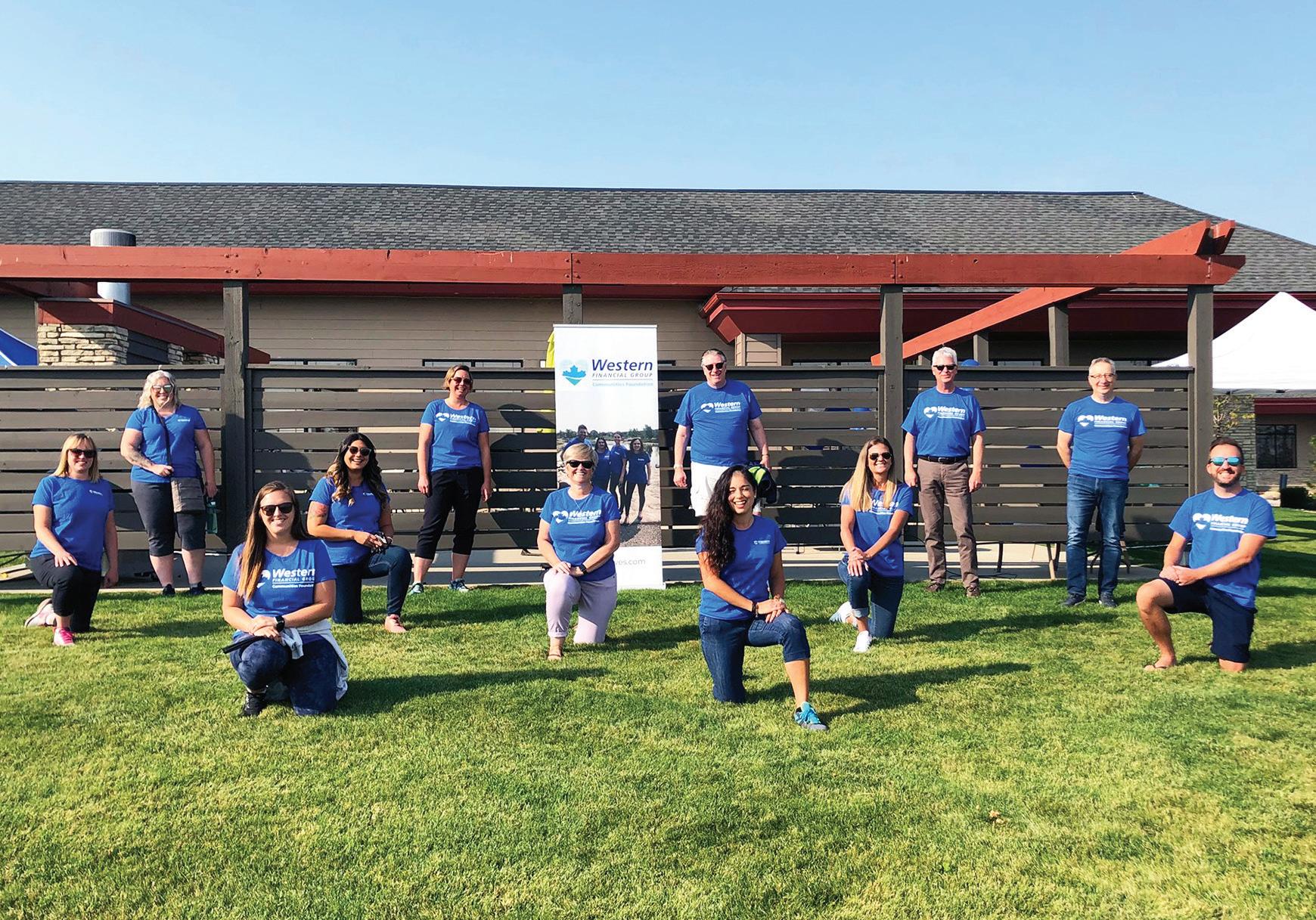
“I admire what our employees do for our communities and people every day and it’s that caring that distinguishes us from our competition,” says Kenny Nicholls, president and CEO of the High River, Alta.-based insurance company.
Building upon those brickand-mortar branches with an innovative call “care” centre offers customers other means to contact service representatives. Although in place since 2018, it’s growing with online and website services.
“We know that time is your most valuable asset because you can’t get that back,” says Ian Aman, vice-president, customer care centre.
“Our role is to help customers and the branch network through the phone channels and it’s super important as people and life get busier. Even though they have the branches, they still like to pick up the phone if they need help from an advisor,” Aman explains.
Adds Nicholls: “We don’t want to become a dinosaur, so we want to give our customers options of how they want to deal with us.”
Western is one of Canada’s largest insurance brokers with more than 220 branches from the Maritimes to British Columbia. However, the company has had deep Albertan roots since opening doors there more than a century ago.
“Alberta is our home. We care deeply about the more than 150,000 Albertans we serve each year and the communities we support and it’s that caring piece we put into everything we do,”
says Nicholls.
It was, that caring lured Aman away from a 20-year stint with a banking institution several months ago.
“The culture here is so strong, innovative and growing and that’s what drew me to Western,” Aman says. “From the time I’ve started here, people deeply care about our customers and they are really embedded in their communities. There’s a shared sense of pride, ownership and commitment.”
Employee volunteer activities coupled with matching corporate donations, an annual fundraising golf tournament and contributions
from the Western Financial Group Communities Foundation help the company support the people it serves.
“It’s really important to give back to the communities who have been supporting us. In the last two years we’ve given back almost $100,000 to Alberta through various programs,” says Nicholls.
Employees have their ears to the ground in their own communities, so they are key to suggesting people and projects.
One example is inspirational awards worth $750 each, given to high school graduates who have battled adversity such as illness or
“We know that time is your most valuable asset because you can’t get that back.”
— Ian Aman Vice-President, Customer Care Centre
a learning disability but want to continue their schooling. Another is an infrastructure program for rebuilding children’s parks, buying library books, restoring baseball diamonds or even helping repair emergency flight helicopters. Each grant is worth $5,000, and six grants have
been given provincially in the last two years.

“It’s not enough to buy a helicopter but it can help with repairs and oftentimes it might be equipment they need to put onboard so that they can save lives,” Nicholls says.
Western also sponsors an annual
National Walk to Support the Cause fundraiser. Bake sales and barbecues are part of the day, with Western donating $50 to the foundation for each employee who participates. This year even the president flipped burgers.

“We invited everyone back to head office to walk and enjoy
a barbecue and it was a great reunion because many of us hadn’t seen each other in two years. I had the executive team accompany me and we did the cooking for everybody,” says Nicholls. He sums up: “We don’t just talk about giving but we actually walk the talk.”
Some people might shy away from a job description that includes dealing with organizational operations around such natural catastrophes as floods and wildfires, but Paul Thorkelsson isn’t among them. In fact, tackling those very challenges were part of what interested him in becoming chief administrative officer with the Regional Municipality of Wood Buffalo.
Headquartered in Fort McMurray, Wood Buffalo is a specialized municipality in northeast Alberta located within Treaty 8 Territory. Consisting of one urban centre and nine rural hamlets, it includes six First Nations and six Métis communities, all with distinct and rich histories.
After working for 20 years in local government in British Columbia, Thorkelsson, who was born and raised in Edmonton, was keen to move back to his home province – and to take on the challenges the CAO’s role poses in the regional municipality. Employee engagement is key to his process.

Thorkelsson is making the rounds and getting to know the people and their important work –
you can find him at 7 a.m. at a fire hall or a landfill, drinking coffee and talking with emergency responders or landfill staff about their work. “When I’m out in the field, I’m hearing different perspectives across the organization, which is really important,” he says.
A recent community engagement session took place in Fort Chipewyan, a community of 1,200 some 200 kilometres from Fort McMurray, accessible only by airplane or boat in the summer
months and an ice road during the winter. “The geographic spread and the diversity of industry, Indigenous history and local government is fascinating,” says Thorkelsson. “And the level of collaboration that goes on both internally and within the broader community is impressive.”
A focus on employees’ mental health and wellness is key to employee satisfaction. “I’m honoured to be on this wellness journey –our culture is taking care of
our people,” says Thorkelsson. Developing and implementing initiatives around diversity and inclusion are part of that culture.
When Krystell O’Hara was hired as a social planner in July 2021, she was already familiar with Wood Buffalo as an employer. “I had worked closely with leaders there, and I knew the municipality was taking important steps to support diversity, equity and inclusion,” she says.
In October 2021, O’Hara was
“I’m helping build bridges and create change, which is exciting.”
— Krystell O’Hara Equity and Inclusion Program Manager
promoted to equity and inclusion program manager, where she aims to create awareness of how discrimination and barriers impact people’s lives. When the opportunity to work as a social planner supporting equity-deserving communities at Wood Buffalo came up, she didn’t hesitate to apply.
O’Hara is particularly proud of an employee-equity survey that generated 700 responses. “We needed to know if employees felt they had a safe workplace where they could be themselves,” she says.

“It helped us have a better understanding of how well we’re doing and what more we need to do.”
An equity and inclusion task force was established to address the survey’s feedback, in order to support both employees and the residents they serve. O’Hara also manages the equity and inclusion office, where employees from different departments and lived experiences advise on strategies,
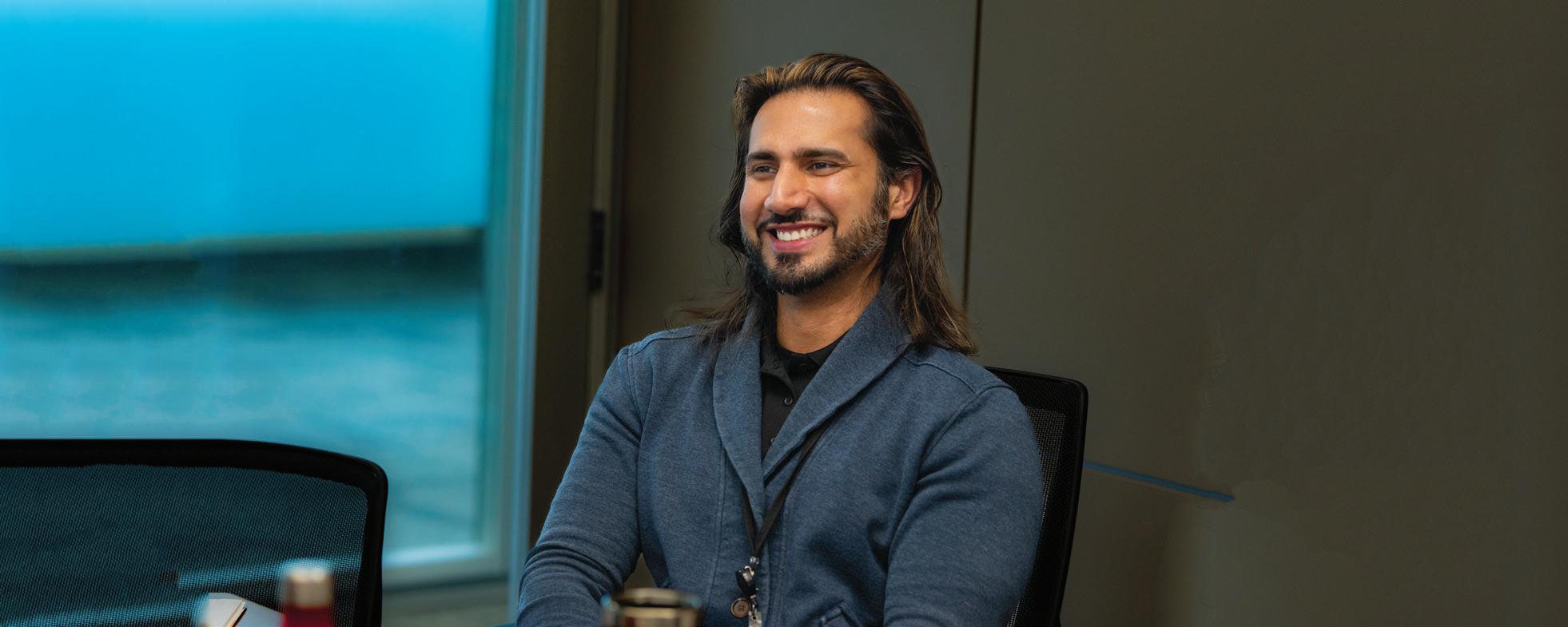
such as inclusive leadership training and anti-racism training.
“We’re creating a workplace that is safe, respectful and welcoming for everyone,” says O’Hara. “We all have a role to play to break down barriers. I’m helping build bridges and create change, which is exciting.”
The CEO of the Workers’ Compensation Board – Alberta says its employees need to be strong and resilient, and well.
“We do noble, important work. We help injured workers with their recovery and to get back to work and to life,” says Trevor Alexander, president and CEO. “But it’s difficult work. We are dealing with people when they are stressed and often very emotional. So, our employees need to be strong and know they are supported. That is why we have a big focus on wellness.”
This focus includes having a corporate wellness department that handles health, safety and wellness programs. The Workers’ Compensation Board (WCB) provides online resources to support employees with personal and professional challenges. Its employee and family assistance program offers 24/7 services to support mental health and other life stresses.
Employees are encouraged to participate in Mental Health Commission of Canada-certified
programs (The Working Mind and Mental Health First Aid) that help participants identify poor mental health and provide skills to manage stress and mental health. An active social committee regularly plans events, such as doughnut days and pancake breakfasts to coincide with summer festivals, and employees can also earn days off through banking extra time worked.
“We treat our team members as a whole person, not just employees,” Alexander says. “We all have our difficult times. So, we want to help our employees feel stronger
and happier. When we do that, we are also more successful in our work.”
Tania Lacroix, disability advisor, corporate wellness, appreciates that WCB’s employee benefits offer flexibility with paramedical services (such as psychology, chiropractic and massage therapy) to allow employees to tailor their benefits to cover the services they need the most. She is also grateful for how the organization handled the switch to a hybrid work model following working from home during the pandemic.
“They turned to us and asked
about our experience working from home and they really listened. They wanted people to feel heard and understood,” Lacroix says.

When employees reported they were happy with the flexibility and work-life balance that operating from home provides, WCB instituted a hybrid model. While there are general guidelines the whole organization must follow, each department has devised a hybrid schedule that fits its needs.
Lacroix is also proud of WCB’s ergonomic program, which she used to facilitate. The program
“We want to help our employees feel stronger and happier. When we do that, we are also more successful in our work.”
— Trevor Alexander President and CEO
2,003 47 60% 100%
educates employees on taking breaks and how to set up a work station, and provides ergonomic equipment for working from home and at the office following a personalized assessment.
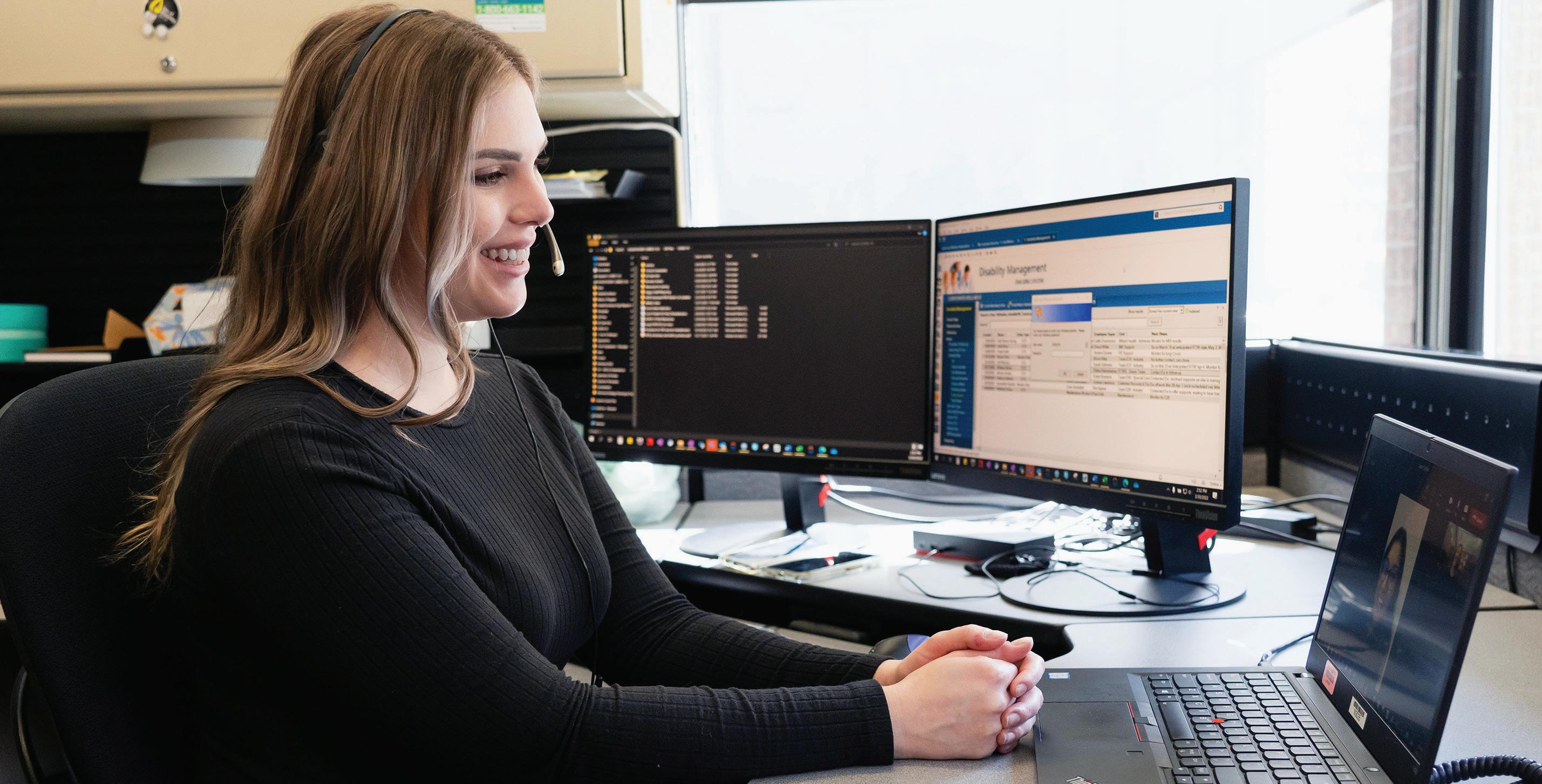

“I am using an ergonomic chair at home that I would not have been able to get for myself, so I
am very thankful for that,” Lacroix says. “We really work to fit the needs of each person. We were able to bring some people back to work who otherwise may not have physically been able to work in the office. We were able to help them continue to be part of the workforce. It was really rewarding
to see that happen.”
Lacroix says all of these programs underline the message that taking care of yourself is the most important thing you can do.
“It is hard to do your job if you are going through something and you don’t have support,” she says.
“It is important that we support
find out more at wcb.ab.ca/about-wcb/careers
employees in their personal life so they can do their work and thrive at home and at the office.
“It sends the message that we care that you are okay and if you are not, that we want to help. It makes me feel like I matter, not just as an employee but as a person.”
